Module 8: Delivering Your Speech
Mastering the location, learning objectives.
Describe techniques for adapting to the physical location of a speech.
Whenever you know you have to speak in a specific place, gather as much information as possible about the speaking space so that you can be prepared and make adjustments that fit the location. Always ask to have time to be in the space before the actual speech to do a rehearsal if time allows.

It’s good to get a sense of the room layout ahead of time, since certain spaces can require some adjustments.
What kinds of information should you acquire when you’ve been asked to speak? See the checklist of questions to ask your host below for a speech that is booked in advance.
- What is the size of the room? (Knowing the size of the room will allow you to adjust your visual aids to be seen in that room. It also allows you to consider how loudly you will need to speak to be heard.)
- How many people are expected to be in the audience? (Having this information allows you to prepare visuals that can be seen by the size of the audience anticipated. It also helps to know this information if you intend to pass out handouts, etc. You should also try to get the information about your audience demographics and their beliefs, attitudes, and values toward your subject. More on this in another section.)
- What is the audio-visual equipment available to be used and who will operate it? (This is critical to the success of the speech delivery. Find out how your visual aids can be displayed; if you can use PowerPoint or Google Slides; and if there’s a projector, pointer, etc.; and if you will be operating the slides or someone else will. You should also find out if microphones are used and/or expected. This will mean adjusting the movement of your speech if it is a handheld microphone that is corded or adjusting your voice volume if you are wearing a lavalier microphone on your lapel, etc.)
- Is there a podium? (Podiums are places where a speaker can set down their notecards. They are also sometimes near the console to operate the room’s computer. If you don’t want the podium, find out if it is removable.)
- When is a possible time to access the room and have a rehearsal? (Always ask for time to be in the space before the audience arrives to see the room layout, test your visuals, and set levels for your sound and speaking voice. If there are separate operators for sound and visuals, they should be at the rehearsal as well.)
For those speaking occasions when you don’t have any information and just have to walk into the space and speak, what should you be prepared for? Everything!

It’s a good idea to have a plan if the AV equipment doesn’t work or if it’s incompatible with your presentation method. Unless you’ve brought transparencies (!), a whole room full of overhead projectors won’t help.
Always have backups for your visual aids. If you’ve prepared a PowerPoint presentation or hope to show video clips, bring your own laptop just in case, but hope that you can use whatever equipment is on site. Put your visuals on a backed-up zip drive so that you can easily transfer it to whatever device or system may be in the room if a laptop connection is not available. Bring a printout of your visuals in case everything else fails and copies can be made as handouts. Have a plan for if your video doesn’t play or was suddenly taken down from YouTube. Prepare a summary of what the clip contained so you can at least narrate what would have happened or have a backup clip in mind so you can switch to it easily.
When you walk into the space, do a quick assessment of the number of audience seats and where they are located. This assessment is for your eye contact and vocal delivery purposes. As quickly as possible, get to wherever you will be operating your visual aids from and turn on everything and see if you can figure out how to operate it all. If not, try to get assistance from someone on site. It is better to lose a few minutes of speaking time and be able to do all you’ve planned than not.
If you feel like the place you are asked to speak from is really far from the audience, don’t be afraid to ask if the audience seating can be quickly reconfigured.
- Event Space, Intermediae Madrid. Authored by : Neil Cummings. Located at : https://flic.kr/p/6kpmTo . License : CC BY-SA: Attribution-ShareAlike
- Overhead projectors. Authored by : Sarah Stewart. Located at : https://flic.kr/p/aKfgB8 . License : CC BY: Attribution
- Mastering the Space. Authored by : Misti Wills with Lumen Learning. License : CC BY: Attribution



Speech on Space
Space, the vast expanse above us, is a mystery waiting to be unraveled. It’s a place where stars twinkle and planets orbit, far beyond what your eyes can see.
You might wonder about the black void you see at night. It’s not empty but filled with galaxies, each teeming with billions of stars just like our sun.
1-minute Speech on Space
Ladies and gentlemen, boys and girls, imagine a place that’s always changing, always expanding, and full of secrets yet to be discovered. That place is space, the final frontier of exploration.
Think about the night sky. Each tiny dot of light you see is a distant star, many with planets just like our Earth orbiting around them. This shows us how vast space really is. It’s a place so big that even light, which travels incredibly fast, can take millions of years to get from one place to another.
Now let’s talk about the beauty of space. When astronauts look back at Earth from space, they don’t see any borders or countries. They see one planet, beautiful and fragile, suspended in the darkness. Space shows us that we are all connected, all living on the same tiny blue dot.
But space is more than just beautiful, it’s useful too. Satellites in space help us predict the weather, navigate our world, and even watch our favorite TV shows. This proves how space exploration can make our lives on Earth better.
Finally, space is the future. Someday, we might be able to live on other planets or meet beings from other worlds. By learning about space, we are opening doors to endless possibilities.
Space is vast, beautiful, useful, and full of potential. It’s our final frontier, a place that will always have new things to teach us, and new places to explore. Let’s look up at the stars and dream big, because in space, anything is possible. Thank you.
Also check:
- Essay on Space
- 10-lines on Space
2-minute Speech on Space
Good day! Let’s talk about something that’s been sparking human curiosity for centuries. It’s big, it’s vast, it’s full of mysteries – it’s the universe! Space, as we call it, is an endless expanse, much like an infinite dark blanket, sprinkled with bright stars.
In the first place, let’s discuss the stars in the sky. You see them every night, sparkling like little diamonds. They look tiny to us, but they’re actually gigantic balls of gas, burning a very, very long way away. Our very own Sun is also a star. It’s the closest one to us, and that’s why it appears so big and bright. Stars are important because they provide light and heat. They’re like the streetlights of the universe.
Secondly, let’s talk about the planets. We live on Earth, which is one of eight planets in our solar system. The others are Mercury, Venus, Mars, Jupiter, Saturn, Uranus, and Neptune. Each one is unique. For example, Mars, known as the Red Planet, and Venus, often called Earth’s twin. We’ve sent spacecraft to all these planets to learn more about them.
Next, let’s talk about something really exciting – space travel. Astronauts are brave explorers who get to go on amazing adventures in space. They travel in spacecraft and sometimes live in space stations, like the International Space Station. They do important work, like studying the effects of living in space and conducting experiments that help us understand more about our universe. Some astronauts have even walked on the moon!
Finally, let’s think about the future of space exploration. Scientists are working on ways for humans to live on other planets, like Mars. Can you imagine that? Living on a different planet! And who knows what else we might discover in the vastness of space. There could be other life forms out there, maybe even civilizations like ours.
Space is a truly fascinating subject. There’s so much we don’t know yet, and that’s what makes it so exciting. Every day, scientists are discovering new things about our universe. And who knows? Maybe one day, some of you will become those scientists, or even astronauts, exploring the unknown and making amazing discoveries. So, let’s keep looking up at the stars and dreaming about the endless possibilities that space holds for us. Thank you!
- Speech on Academic Excellence
- Speech on Academic Achievement Award
- Speech on Abraham Lincoln Freedom
We also have speeches on more interesting topics that you may want to explore.
Leave a Reply Cancel reply
Your email address will not be published. Required fields are marked *
Save my name, email, and website in this browser for the next time I comment.


9 ways to use space in your presentation
by Olivia Mitchell | 9 comments

There are many benefits to movement in a presentation:
- It adds energy and variety to your presentation.
- It makes you look more confident – because people who are nervous are generally frozen in one spot.
- And as an added bonus, if you move, you may start to feel more confident. That’s partly because movement will help dissipate the extra adrenalin in your system.
Movement got a bad name because of university lecturers pacing up and down. Audiences are distracted by mindless, repetitive movement. Movement should be interspersed with stillness. That way, they both have more impact.
Incorporate movement in your presentation by planning different positions on the stage (or front of the room) that you’ll present from. In the theatre, this is called “ blocking “. Blocking is deciding on the position and movement of the characters as they move through the play. You can block your presentation too. Here are some ideas:
1. State your Key Message from the Power Position
Your Key Message is the core of your talk. Choose one spot where you will stand and state your Key Message. It should be dead centre, and close to the audience.

2. Map your structure on the stage
Using your physical space on the stage to map out your structure. It will help your audience anchor the different parts of your talk. Use these areas when you do a preview near the beginning of your presentation. Then return to that area of the stage for that part of the presentation.

3. Use a stage timeline
Where a story or explanation involves the passage of time, imagine a timeline across the stage and move along it to show the progression of time. Remember to make the past to the audience’s left – not your left.

4. Argue the pros and cons as if you were in a debate
In a debate, the people arguing for each side will stand at different sides of the stage. Although there’s only one of you, you can adopt this strategy. Stand on one side for the pros – and the other side for the cons.

5. Physically reflect the continuum of points of view
Points of view on a topic often exist along a continuum – from one extreme – to middle of the road – and out to the other extreme. Reflect this with where you stand on the stage as you describe each point of view.

6. Give each option it’s own spot
If you’re discussing a range of options, stand in a specific spot for each option as you describe it. When you refer back to an option later in your presentation, go back to that spot.

7. Story time
Have a general area of the stage for story-telling. When you’re telling a light-hearted story, it can be effective to move around as you’re talking. You’ll come across as chatty and conversational.

Where a story involves two or more characters in dialogue, have a specific spot where you deliver the lines of each character. Stay within the storytelling area.

8. Move close for emphasis
If you normally stay a couple of paces back from your audience, you can then exploit closeness for empashis. Moving close to people is powerful. Even intimidating. But you can stand really close to someone, and look elsewhere. You get the powerful effect without intimidation.

9. Dance with your Slides
Adding the display of slides is a complicating factor. To keep as much flexibility as possible, I recommend placing the datashow screen slightly off to the side. If the screen is in the middle, it’s easy to turn into a projectionist instead of a presenter. If it’s to the side, then you can still claim the power position. To avoid stepping into the beam of the datashow, stick some duct tape on the floor as a reminder. (Note: I generally have the screen to my right because I also use a flipchart which I like to have to my left, so that when I turn around to write on the flipchart, I don’t have to move to the other side of it. I’m right-handed – if you’re left-handed, you’d flip this arrangement around).

You’ll also need to be aware of blocking the view of some parts of the audience. With this arrangement if you move slightly back and to the side, it will allow everyone in the audience to see. When they’ve seen the slide, move back closer to the audience, as you’ll lose impact standing further back for a long period of time.

When you want to draw attention to a slide, move back to your datashow screen.

Explain your slides physically. Get in the beam. For a great example of explaining slides physically have a watch of Hans Rosling explaining statistics like you’ve never seen before. You’ll never use a wimpy laser pointer again!
Choose one or two of these ideas to implement to begin with. If possible, rehearse in the room that you’re presenting in, so that you can integrate the movements you want to make. Generally, it’s more natural and conversational to keep talking as you’re moving. But occasionally use the power of silence for more impact.
Using your space will add a new dimension to your presentations.
Free Course
How to tame your fear of public speaking.
In this video-training series (plus workbook with transcripts) you’ll learn:
- The three things you must know BEFORE you begin to tackle your fear of public speaking
- Why the positive-negative thought classification doesn’t work for fear of public speaking
- The two powerful self-talk tweaks that can make an immediate difference.
You have Successfully Subscribed!
I ask for your email address to deliver the course to you and so that I can keep on supporting and encouraging you with tips, ideas and inspiration. I will also let you know when my group program is open for enrolment. I will keep your email safe and you can unsubscribe at any time.
Hello Olivia,
I really enjoyed your text about space and movement in presentations. In fact, I made a summary in Spanish in my blog and linked to your post.
I wonder if I also could use and insert your images in my post or create another ones with spanish text.
Thanks! Carles.
Thanks for the tips! I will try and remember these when I am next up front speaking.
Good piece of information 🙂
Great hints! I’ll try them next time I teach a class!
wonderful tips for trainers and teachers thank you
Thanks for the stage time line explanation. I had to explain this to my Gavel Club kids for story telling and needed to get it right!
Great job. Very well said and explained. Really helpful and reliable indeed.Thanks for sharing this and keep up the good work, very much appreciated
hi good day
A good read
Trackbacks/Pingbacks
- mark larson | - [...] are 9 ways to use space in your presentation, basically ways to use your body on stage while you’re…
- Crushing Krisis › Stuff I have bookmarked, but never investigated. - [...] How to use space in a presentation (Just now cribbed from MLarson; if I remember this exists I will…
- How to Look Authoritative | MC2TALKS - [...] For more ideas on moving such as mapping your structure, showing a timeline and picking a storytelling spot, check…
- ??????? ??????? ?? ??? ?? ???????? | ????????? ????? - [...] ???? ???? ??????? ? ??????? ????? ??:???????? ??????? ????? ??????? ????????? ???????? (1) ??????? ????????? ???????? (2)???????? ??? ??…
- Reaching My Objectives | Lindsay Zengler - [...] http://www.speakingaboutpresenting.com/delivery/9-ways-space-presentation/ [...]
- Should I Move While Delivering a Speech or Presentation? | Communication Matters - […] is an article by Olivia Mitchell on effective use of the […]
- Research on Goals – Aine Javier COMMS 101 - […] https://speakingaboutpresenting.com/delivery/9-ways-space-presentation/ […]
Need to be more relaxed when you deliver your next presentation?
Learn a system that will allow you to focus on engaging with your audience - not worrying about what you're saying.

Recent posts
- Why striving to be authentic can be a trap
- The first time is never the best
- The Need to be Knowledgeable
- Would you wear clothes that clash?
- An unconventional approach to overcoming the fear of public speaking
Connect With Me

Recommended Books
Click here to see my favorite presentation books.
I earn a small commission when you buy a book from this page. Thank you!
- Audience (22)
- Content (62)
- Delivery (31)
- Nervousness (30)
- Powerpoint (37)
- Presentation blogs (2)
- Presentation books (4)
- Presentation critiques (9)
- Presentation myths (6)
- Presentation philosophy (5)
- Presentation research (11)
- Presentation skills (23)
- Presenting with Twitter (10)
- Visual thinking (3)
How to Tame your Fear of Public Speaking
- Do you have to perform perfectly?
- Do you beat yourself up if you don't?
- Would you talk to a friend the way you talk to yourself?
- Does it make sense that if you changed the way you talked to yourself, you could reduce your fear of public speaking?
I will show you exactly how in this free video training series and workbook.
Discover more from Speaking about Presenting
Subscribe now to keep reading and get access to the full archive.
Type your email…
Continue reading

Speechwriting
9 Structure and Organization
Writing a Speech That Audiences Can Grasp
In this chapter . . .
For a speech to be effective, the material must be presented in a way that makes it not only engaging but easy for the audience to follow. Having a clear structure and a well-organized speech makes this possible. In this chapter we cover the elements of a well-structured speech, using transitions to connect each element, and patterns for organizing the order of your main points.
Have you had this experience? You have an instructor who is easy to take notes from because they help you see the main ideas and give you cues as to what is most important to write down and study for the test. On the other hand, you might have an instructor who tells interesting stories, says provocative things, and leads engaging discussions, but you have a tough time following where the instruction is going. If you’ve experienced either of these, you already know that structure and the organized presentation of material makes a big difference for listening and learning. The structure is like a house, which has essential parts like a roof, walls, windows, and doors. Organization is like the placement of rooms within the house, arranged for a logical and easy flow.
This chapter will teach you about creating a speech through an outlining process that involves structure and organization. In the earlier chapter Ways of Delivering Speeches , you learned about several different modes of speech delivery: impromptu, extemporaneous, and manuscript. Each of these suggests a different kind of speech document. An impromptu speech will have a very minimal document or none at all. An extemporaneous delivery requires a very thorough outline, and a manuscript delivery requires a fully written speech text. Here’s a crucial point to understand: Whether you plan to deliver extemporaneously or from a fully written text. The process of outlining is crucial. A manuscript is simply a thorough outline into which all the words have been written.
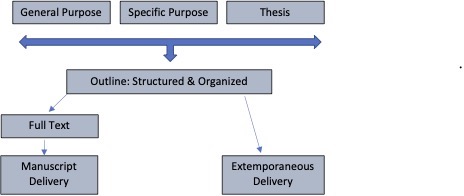
Four Elements of a Structured Speech
A well-structured speech has four distinct elements: introduction, body, connective statements, and conclusion. While this sounds simple, each of these elements has sub-elements and nuances that are important to understand. Introductions and conclusions are complex enough to warrant their own chapter and will be discussed in depth further on.
Introduction and Conclusion
The importance of a good introduction cannot be overstated. The clearer and more thorough the introduction, the more likely your audience will listen to the rest of the speech and not “turn off.” An introduction, which typically occupies 10-15% of your entire speech, serves many functions including getting the audience’s attention, establishing your credibility, stating your thesis, and previewing your main points.
Like an introduction, speech conclusions are essential. They serve the function of reiterating the key points of your speech and leave the audience with something to remember.
The elements of introductions and conclusions will be discussed in the following chapter. The remainder of this chapter is devoted to the body of the speech and its connectors.
The Body of a Speech
The body of a speech is comprised of several distinct groups of related information or arguments. A proper group is one where a) the group can be described in a single clear sentence, and b) there’s a logical relationship between everything within it. We call that describing sentence a main point . Speeches typically have several main points, all logically related to the thesis/central idea of the speech. Main points are followed by explanation, elaboration, and supporting evidence that are called sub-points .
Main Points
A main point in a speech is a complete sentence that states the topic for information that is logically grouped together. In a writing course, you may have learned about writing a paragraph topic sentence. This is typically the first sentence of a paragraph and states the topic of the paragraph. Speechwriting is similar. Whether you’re composing an essay with a paragraph topic sentences or a drafting a speech with main points, everything in the section attached to the main point should logically pertain to it. If not, then the information belongs under a different main point. Let’s look at an example of three main points:
General Purpose: To persuade
Specific Purpose: To motivate my classmates in English 101 to participate in a study abroad program.
Thesis: A semester-long study abroad experience produces lifelong benefits by teaching you about another culture, developing your language skills, and enhancing your future career prospects.
Main point #1: A study abroad experience allows you to acquire firsthand experience of another culture through classes, extra-curricular activities, and social connections.
Main point #2: You’ll turbocharge your acquisition of second language skills through an immersive experience living with a family.
Main point #3: A study abroad experience on your resume shows that you have acquired the kind of language and cultural skills that appeal to employers in many sectors.
Notice that each main point is expressed in a complete sentence, not merely #1 Culture; #2 Language; #3 Career. One-word signals are useless as a cue for speaking. Additionally, students are often tempted to write main points as directions to themselves, “Talk about the health department” or “Mention the solution.” This isn’t helpful for you, either. Better: “The health department provides many services for low-income residents” says something we can all understand.
Finally, the important thing to understand about speechwriting is that listeners have limits as to how many categories of information they can keep in mind. The number of main points that can be addressed in any speech is determined by the time allotted for a speech but is also affected by the fact that speeches are limited in their ability to convey substantial amounts of information. For a speech of five to seven minutes, three or four main points are usually enough. More than that would be difficult to manage—for both speaker and audience.
Obviously, creating your main points isn’t the end of the story. Each main point requires additional information or reinforcement. We call these sub-points. Sub-points provide explanation, detail, elaboration, and/or supporting evidence. Consider main point #1 in the previous example, now with sub-points:
Sub-point A: How a country thinks about education is a window into the life of that culture. While on a study abroad program, you’ll typically take 3-5 classes at foreign universities, usually with local professors. This not only provides new learning, but it opens your eyes to different modes of education.
Sub-point B: Learning about a culture isn’t limited to the classroom. Study abroad programs include many extra-curricular activities that introduce you to art, food, music, sports, and other everyday elements of a country’s culture. These vary depending on the program and there’s something for everyone! The website gooverseas.com provides information on hundreds of programs.
Sub-point C: The opportunity to socialize with peers in other countries is one of most attractive elements of studying abroad. You may form friendships that will last a lifetime. “I have made valuable connections in a country I hope to return to someday” according to a blog post by Rachel Smith, a student at the University of Kansas. [1]
Notice that each of these sub-points pertains to the main point. The sub-points contribute to the main point by providing explanation, detail, elaboration, and/or supporting evidence. Now imagine you had a fourth sub-point:
Sub-point D: And while doing all that socializing, you’ll really improve your language skills.
Does that sub-point belong to main point #1? Or should it be grouped with main point#2 or main point #3?
Connective Statements
Connectives or “connective statements” are broad terms that encompass several types of statements or phrases. They are designed to help “connect” parts of your speech to make it easier for audience members to follow. Connectives are tools that add to the planned redundancy, and they are methods for helping the audience listen, retain information, and follow your structure. In fact, it’s one thing to have a well-organized speech. It’s another for the audience to be able to “consume” or understand that organization.
Connectives in general perform several functions:
- Remind the audience of what has come before
- Remind the audience of the central focus or purpose of the speech
- Forecast what is coming next
- Help the audience have a sense of context in the speech—where are we?
- Explain the logical connection between the previous main idea(s) and next one or previous sub-points and the next one
- Explain your own mental processes in arranging the material as you have
- Keep the audience’s attention through repetition and a sense of movement
Connective statement can include “internal summaries,” “internal previews” “signposts” and “bridging or transition statements.” Each of these helps connect the main ideas of your speech for the audience, but they have different emphases and are useful for different types of speeches.
Types of connectives and examples
Internal summaries emphasize what has come before and remind the audience of what has been covered.
“So far I have shown how the designers of King Tut’s burial tomb used the antechamber to scare away intruders and the second chamber to prepare royal visitors for the experience of seeing the sarcophagus.”
Internal previews let your audience know what is coming up next in the speech and what to expect regarding the content of your speech.
“In this next part of the presentation I will share with you what the truly secret and valuable part of the King Tut’s pyramid: his burial chamber and the treasury.”
Signposts emphasize physical movement through the speech content and let the audience know exactly where they are. Signposting can be as simple as “First,” “Next,” “Lastly” or numbers such as “First,” “Second,” Third,” and “Fourth.” Signposting is meant to be a brief way to let your audience know where they are in the speech. It may help to think of these like the mile markers you see along interstates that tell you where you’re and how many more miles you will travel until you reach your destination.
“The second aspect of baking chocolate chip cookies is to combine your ingredients in the recommended way.”
Bridging or transition statements emphasize moving the audience psychologically to the next step.
“I have mentioned two huge disadvantages to students who don’t have extracurricular music programs. Let me ask: Is that what we want for our students? If not, what can we do about it?”
They can also serve to connect seemingly disconnected (but related) material, most commonly between your main points.
“After looking at how the Cherokee Indians of the North Georgia mountain region were politically important until the 1840s and the Trail of Tears, we can compare their experience with that of the Indians of Central Georgia who did not assimilate in the same way as the Cherokee.”
At a minimum, a bridge or transition statement is saying, “Now that we have looked at (talked about, etc.) X, let’s look at Y.”
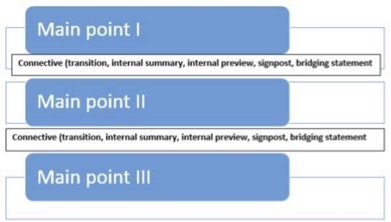
There’s no standard format for connectives. However, there are a few pieces of advice to keep in mind about them:
First, connectives are for connecting main points. They are not for providing evidence, statistics, stories, examples, or new factual information for the supporting points of the main ideas of the speech.
Second, while connectives in essay writing can be relatively short—a word or phrase, in public speaking, connectives need to be a sentence or two. When you first start preparing and practicing connectives, you may feel that you’re being too obvious with them, and they are “clunky.” Some connectives may seem to be hitting the audience over the head with them like a hammer. While it’s possible to overdo connectives, it’s less likely than you would think. The audience will appreciate them, and as you listen to your classmates’ speeches, you’ll become aware of when they are present and when they are absent.
Lack of connectives results in hard-to-follow speeches where the information seems to come up unexpectedly or the speaker seems to jump to something new without warning or clarification.
Finally, you’ll also want to vary your connectives and not use the same one all the time. Remember that there are several types of connectives.
Patterns of Organization
At the beginning of this chapter, you read the analogy that a speech structure is like a house and organization is like the arrangement of the rooms. So far, we have talked about structure. The introduction, body, main point, sub-point, connectives—these are the house. But what about the arrangement of the rooms? How will you put your main points in a logical order?
There are some standard ways of organizing the body of a speech. These are called “patterns of organization.” In each of the examples below, you’ll see how the specific purpose gives shape to the organization of the speech and how each one exemplifies one of the six main organizational patterns.
Please note that these are simple, basic outlines for example purposes. The actual content of the speech outline or manuscript will be much further developed.
Chronological Pattern
Specific Purpose: To describe to my classmates the four stages of rehabilitation in addiction recovery.
Main Points:
- The first stage is acknowledging the problem and entering treatment.
- The second stage is early abstinence, a difficult period in the rehabilitation facility.
- The third stage is maintaining abstinence after release from the rehab facility.
- The fourth stage is advanced recovery after a period of several years.
The example above uses what is termed the chronological pattern of organization . Chronological always refers to time order. Organizing your main points chronologically is usually appropriate for process speeches (how-to speeches) or for informational speeches that emphasize how something developed from beginning to end. Since the specific purpose in the example above is about stages, it’s necessary to put the four stages in the right order. It would make no sense to put the fourth stage second and the third stage first.
Chronological time can be long or short. If you were giving a speech about the history of the Civil Rights Movement, that period would cover several decades; if you were giving a speech about the process of changing the oil in a car, that process takes less than an hour. Whether the time is long or short, it’s best to avoid a simple, chronological list of steps or facts. A better strategy is to put the information into three to five groups so that the audience has a framework. It would be easy in the case of the Civil Rights Movement to list the many events that happened over more than two decades, but that could be overwhelming for the audience. Instead, your chronological “grouping” might be:
- The movement saw African Americans struggling for legal recognition before the landmark 1954 Brown v. Board of Education decision.
- The movement was galvanized and motivated by the 1955-1956 Montgomery Bus Boycott.
- The movement saw its goals met in the Civil Rights Act of 1965.
In this way, the chronological organization isn’t an overwhelming list of events. It focuses the audience on three events that pushed the Civil Rights movement forward.
Spatial Pattern
You can see that chronological is a highly-used organizational structure, since one of the ways our minds work is through time-orientation—past, present, future. Another common thought process is movement in space or direction, which is called the spatial pattern . For example:
Specific Purpose: To explain to my classmates the three regional cooking styles of Italy.
- In the mountainous region of the North, the food emphasizes cheese and meat.
- In the middle region of Tuscany, the cuisine emphasizes grains and olives.
- In the southern region and Sicily, the diet is based on fish and seafood.
In this example, the content is moving from northern to southern Italy, as the word “regional” would indicate. For a more localized example:
Specific Purpose: To explain to my classmates the layout of the White House.
- The East Wing includes the entrance ways and offices for the First Lady.
- The most well-known part of the White House is the West Wing.
- The residential part of the White House is on the second floor. (The emphasis here is the movement a tour would go through.)
For an even more localized example:
Specific Purpose: To describe to my Anatomy and Physiology class the three layers of the human skin.
- The outer layer is the epidermis, which is the outermost barrier of protection.
- The second layer beneath is the dermis.
- The third layer closest to the bone is the hypodermis, made of fat and connective tissue.
Topical / Parts of the Whole Pattern
The topical organizational pattern is probably the most all-purpose, in that many speech topics could use it. Many subjects will have main points that naturally divide into “types of,” “kinds of,” “sorts of,” or “categories of.” Other subjects naturally divide into “parts of the whole.” However, as mentioned previously, you want to keep your categories simple, clear, distinct, and at five or fewer.
Specific Purpose: To explain to my first-year students the concept of SMART goals.
- SMART goals are specific and clear.
- SMART goals are measurable.
- SMART goals are attainable or achievable.
- SMART goals are relevant and worth doing.
- SMART goals are time-bound and doable within a time period.
Specific Purpose: To explain the four characteristics of quality diamonds.
- Valuable diamonds have the characteristic of cut.
- Valuable diamonds have the characteristic of carat.
- Valuable diamonds have the characteristic of color.
- Valuable diamonds have the characteristic of clarity.
Specific Purpose: To describe to my audience the four main chambers of a human heart.
- The first chamber in the blood flow is the right atrium.
- The second chamber in the blood flow is the right ventricle.
- The third chamber in the blood flow is the left atrium.
- The fourth chamber in the blood flow and then out to the body is the left ventricle.
At this point in discussing organizational patterns and looking at these examples, two points should be made about them and about speech organization in general:
First, you might look at the example about the chambers of the heart and say, “But couldn’t that be chronological, too, since that’s the order of the blood flow procedure?” Yes, it could. There will be times when a specific purpose could work with two different organizational patterns. In this case, it’s just a matter of emphasis. This speech emphasizes the anatomy of the heart, and the organization is “parts of the whole.” If the speech’s specific purpose were “To explain to my classmates the flow of blood through the chambers of the heart,” the organizational pattern would emphasize chronological, altering the pattern.
Another principle of organization to think about when using topical organization is “climax” organization. That means putting your strongest argument or most important point last when applicable. For example:
Specific purpose: To defend before my classmates the proposition that capital punishment should be abolished in the United States.
- Capital punishment does not save money for the justice system.
- Capital punishment does not deter crime in the United States historically.
- Capital punishment has resulted in many unjust executions.
In most people’s minds, “unjust executions” is a bigger reason to end a practice than the cost, since an unjust execution means the loss of an innocent life and a violation of our principles. If you believe Main Point III is the strongest argument of the three, putting it last builds up to a climax.
Cause & Effect Pattern
If the specific purpose mentions words such as “causes,” “origins,” “roots of,” “foundations,” “basis,” “grounds,” or “source,” it’s a causal order; if it mentions words such as “effects,” “results,” “outcomes,” “consequences,” or “products,” it’s effect order. If it mentions both, it would of course be cause/effect order. This example shows a cause/effect pattern:
Specific Purpose: To explain to my classmates the causes and effects of schizophrenia.
- Schizophrenia has genetic, social, and environmental causes.
- Schizophrenia has educational, relational, and medical effects.
Problem-Solution Pattern
The principle behind the problem-solution pattern is that if you explain a problem to an audience, you shouldn’t leave them hanging without solutions. Problems are discussed for understanding and to do something about them. This is why the problem-solution pattern is often used for speeches that have the objective of persuading an audience to take action.
When you want to persuade someone to act, the first reason is usually that something needs fixing. Let’s say you want the members of the school board to provide more funds for music at the three local high schools in your county. What is missing because music or arts are not funded? What is the problem ?
Specific Purpose: To persuade the members of the school board to take action to support the music program at the school.
- Students who don’t have extracurricular music in their lives have lower SAT scores.
- Schools that don’t have extracurricular music programs have more gang violence and juvenile delinquency.
- $120,000 would go to bands.
- $80,000 would go to choral programs.
Of course, this is a simple outline, and you would need to provide evidence to support the arguments, but it shows how the problem-solution pattern works.
Psychologically, it makes more sense to use problem-solution rather than solution-problem. The audience will be more motivated to listen if you address needs, deficiencies, or problems in their lives rather than giving them solutions first.
Problem-Cause-Solution Pattern
A variation of the problem-solution pattern, and one that sometimes requires more in-depth exploration of an issue, is the “problem-cause-solution” pattern. If you were giving a speech on the future extinction of certain animal species, it would be insufficient to just explain that numbers of species are about to become extinct. Your second point would logically have to explain the cause behind this happening. Is it due to climate change, some type of pollution, encroachment on habitats, disease, or some other reason? In many cases, you can’t really solve a problem without first identifying what caused the problem.
Specific Purpose: To persuade my audience that the age to obtain a driver’s license in the state of Georgia should be raised to 18.
- There’s a problem in this country with young drivers getting into serious automobile accidents leading to many preventable deaths.
- One of the primary causes of this is younger drivers’ inability to remain focused and make good decisions due to incomplete brain development.
- One solution that will help reduce the number of young drivers involved in accidents would be to raise the age for obtaining a driver’s license to 18.
Some Additional Principles of Speech Organization
It’s possible that you may use more than one of these organizational patterns within a single speech. You should also note that in all the examples to this point (which have been kept simple for the purpose of explanation), each main point is relatively equal in emphasis; therefore, the time spent on each should be equal as well. You would not want your first main point to be 30 seconds long, the second one to be 90 seconds, and the third 3 minutes. For example:
Specific Purpose: To explain to my classmates the rules of baseball.
- Baseball has rules about equipment.
- Baseball has rules about the numbers of players.
- Baseball has rules about play.
Main Point #2 isn’t really equal in size to the other two. There’s a great deal you could say about equipment and even more about the rules of playing baseball, but the number of players would take you about ten seconds to say. If Main Point #2 were “Baseball has rules about the positions on the field,” that would make more sense and be closer in level of importance to the other two.
The organization of your speech may not be the most interesting part to think about, but without it, great ideas will seem jumbled and confusing to your audience. Even more, good connectives will ensure your audience can follow you and understand the logical connections you’re making with your main ideas. Finally, because your audience will understand you better and perceive you as organized, you’ll gain more credibility as a speaker if you’re organized. A side benefit to learning to be an organized public speaker is that your writing skills will improve, specifically your organization and sentence structure.
Roberto is thinking about giving an informative speech on the status of HIV-AIDS currently in the U.S. He has different ideas about how to approach the speech. Here are his four main thoughts:
- pharmaceutical companies making drugs available in the developing world
- changes in attitudes toward HIV-AIDS and HIV-AIDS patients over the last three decades
- how HIV affects the body of a patient
- major breakthroughs in HIV-AIDS treatment
Assuming all these subjects would be researchable and appropriate for the audience, write specific purpose statements for each. What organizational patterns would he probably use for each specific purpose?
Media Attributions
- Speech Structure Flow © Mechele Leon is licensed under a CC BY-NC-SA (Attribution NonCommercial ShareAlike) license
- Connectives
- https://blog-college.ku.edu/tag/study-abroad-stories/ ↵
Public Speaking as Performance Copyright © 2023 by Mechele Leon is licensed under a Creative Commons Attribution-NonCommercial-ShareAlike 4.0 International License , except where otherwise noted.

Want to create or adapt books like this? Learn more about how Pressbooks supports open publishing practices.
10.2 Using Common Organizing Patterns
Learning objectives.
- Differentiate among the common speech organizational patterns: categorical/topical, comparison/contrast, spatial, chronological, biographical, causal, problem-cause-solution, and psychological.
- Understand how to choose the best organizational pattern, or combination of patterns, for a specific speech.

Twentyfour Students – Organization makes you flow – CC BY-SA 2.0.
Previously in this chapter we discussed how to make your main points flow logically. This section is going to provide you with a number of organization patterns to help you create a logically organized speech. The first organization pattern we’ll discuss is categorical/topical.
Categorical/Topical
By far the most common pattern for organizing a speech is by categories or topics. The categories function as a way to help the speaker organize the message in a consistent fashion. The goal of a categorical/topical speech pattern is to create categories (or chunks) of information that go together to help support your original specific purpose. Let’s look at an example.
In this case, we have a speaker trying to persuade a group of high school juniors to apply to attend Generic University. To persuade this group, the speaker has divided the information into three basic categories: what it’s like to live in the dorms, what classes are like, and what life is like on campus. Almost anyone could take this basic speech and specifically tailor the speech to fit her or his own university or college. The main points in this example could be rearranged and the organizational pattern would still be effective because there is no inherent logic to the sequence of points. Let’s look at a second example.
In this speech, the speaker is talking about how to find others online and date them. Specifically, the speaker starts by explaining what Internet dating is; then the speaker talks about how to make Internet dating better for her or his audience members; and finally, the speaker ends by discussing some negative aspects of Internet dating. Again, notice that the information is chunked into three categories or topics and that the second and third could be reversed and still provide a logical structure for your speech
Comparison/Contrast
Another method for organizing main points is the comparison/contrast speech pattern . While this pattern clearly lends itself easily to two main points, you can also create a third point by giving basic information about what is being compared and what is being contrasted. Let’s look at two examples; the first one will be a two-point example and the second a three-point example.
If you were using the comparison/contrast pattern for persuasive purposes, in the preceding examples, you’d want to make sure that when you show how Drug X and Drug Y differ, you clearly state why Drug X is clearly the better choice for physicians to adopt. In essence, you’d want to make sure that when you compare the two drugs, you show that Drug X has all the benefits of Drug Y, but when you contrast the two drugs, you show how Drug X is superior to Drug Y in some way.
The spatial speech pattern organizes information according to how things fit together in physical space. This pattern is best used when your main points are oriented to different locations that can exist independently. The basic reason to choose this format is to show that the main points have clear locations. We’ll look at two examples here, one involving physical geography and one involving a different spatial order.
If you look at a basic map of the United States, you’ll notice that these groupings of states were created because of their geographic location to one another. In essence, the states create three spatial territories to explain.
Now let’s look at a spatial speech unrelated to geography.
In this example, we still have three basic spatial areas. If you look at a model of the urinary system, the first step is the kidney, which then takes waste through the ureters to the bladder, which then relies on the sphincter muscle to excrete waste through the urethra. All we’ve done in this example is create a spatial speech order for discussing how waste is removed from the human body through the urinary system. It is spatial because the organization pattern is determined by the physical location of each body part in relation to the others discussed.
Chronological
The chronological speech pattern places the main idea in the time order in which items appear—whether backward or forward. Here’s a simple example.
In this example, we’re looking at the writings of Winston Churchill in relation to World War II (before, during, and after). By placing his writings into these three categories, we develop a system for understanding this material based on Churchill’s own life. Note that you could also use reverse chronological order and start with Churchill’s writings after World War II, progressing backward to his earliest writings.
Biographical
As you might guess, the biographical speech pattern is generally used when a speaker wants to describe a person’s life—either a speaker’s own life, the life of someone they know personally, or the life of a famous person. By the nature of this speech organizational pattern, these speeches tend to be informative or entertaining; they are usually not persuasive. Let’s look at an example.
In this example, we see how Brian Warner, through three major periods of his life, ultimately became the musician known as Marilyn Manson.
In this example, these three stages are presented in chronological order, but the biographical pattern does not have to be chronological. For example, it could compare and contrast different periods of the subject’s life, or it could focus topically on the subject’s different accomplishments.
The causal speech pattern is used to explain cause-and-effect relationships. When you use a causal speech pattern, your speech will have two basic main points: cause and effect. In the first main point, typically you will talk about the causes of a phenomenon, and in the second main point you will then show how the causes lead to either a specific effect or a small set of effects. Let’s look at an example.
In this case, the first main point is about the history and prevalence of drinking alcohol among Native Americans (the cause). The second point then examines the effects of Native American alcohol consumption and how it differs from other population groups.
However, a causal organizational pattern can also begin with an effect and then explore one or more causes. In the following example, the effect is the number of arrests for domestic violence.
In this example, the possible causes for the difference might include stricter law enforcement, greater likelihood of neighbors reporting an incident, and police training that emphasizes arrests as opposed to other outcomes. Examining these possible causes may suggest that despite the arrest statistic, the actual number of domestic violence incidents in your city may not be greater than in other cities of similar size.
Problem-Cause-Solution
Another format for organizing distinct main points in a clear manner is the problem-cause-solution speech pattern . In this format you describe a problem, identify what you believe is causing the problem, and then recommend a solution to correct the problem.
In this speech, the speaker wants to persuade people to pass a new curfew for people under eighteen. To help persuade the civic group members, the speaker first shows that vandalism and violence are problems in the community. Once the speaker has shown the problem, the speaker then explains to the audience that the cause of this problem is youth outside after 10:00 p.m. Lastly, the speaker provides the mandatory 10:00 p.m. curfew as a solution to the vandalism and violence problem within the community. The problem-cause-solution format for speeches generally lends itself to persuasive topics because the speaker is asking an audience to believe in and adopt a specific solution.
Psychological
A further way to organize your main ideas within a speech is through a psychological speech pattern in which “a” leads to “b” and “b” leads to “c.” This speech format is designed to follow a logical argument, so this format lends itself to persuasive speeches very easily. Let’s look at an example.
In this speech, the speaker starts by discussing how humor affects the body. If a patient is exposed to humor (a), then the patient’s body actually physiologically responds in ways that help healing (b—e.g., reduces stress, decreases blood pressure, bolsters one’s immune system, etc.). Because of these benefits, nurses should engage in humor use that helps with healing (c).
Selecting an Organizational Pattern
Each of the preceding organizational patterns is potentially useful for organizing the main points of your speech. However, not all organizational patterns work for all speeches. For example, as we mentioned earlier, the biographical pattern is useful when you are telling the story of someone’s life. Some other patterns, particularly comparison/contrast, problem-cause-solution, and psychological, are well suited for persuasive speaking. Your challenge is to choose the best pattern for the particular speech you are giving.
You will want to be aware that it is also possible to combine two or more organizational patterns to meet the goals of a specific speech. For example, you might wish to discuss a problem and then compare/contrast several different possible solutions for the audience. Such a speech would thus be combining elements of the comparison/contrast and problem-cause-solution patterns. When considering which organizational pattern to use, you need to keep in mind your specific purpose as well as your audience and the actual speech material itself to decide which pattern you think will work best.
Key Takeaway
- Speakers can use a variety of different organizational patterns, including categorical/topical, comparison/contrast, spatial, chronological, biographical, causal, problem-cause-solution, and psychological. Ultimately, speakers must really think about which organizational pattern best suits a specific speech topic.
- Imagine that you are giving an informative speech about your favorite book. Which organizational pattern do you think would be most useful? Why? Would your answer be different if your speech goal were persuasive? Why or why not?
- Working on your own or with a partner, develop three main points for a speech designed to persuade college students to attend your university. Work through the preceding organizational patterns and see which ones would be possible choices for your speech. Which organizational pattern seems to be the best choice? Why?
- Use one of the common organizational patterns to create three main points for your next speech.
Stand up, Speak out Copyright © 2016 by University of Minnesota is licensed under a Creative Commons Attribution-NonCommercial-ShareAlike 4.0 International License , except where otherwise noted.
Share This Book

Want to create or adapt books like this? Learn more about how Pressbooks supports open publishing practices.
7 Building and Organizing Your Speech
Learning objectives.
- Understand how to make the transition from a specific purpose to a series of main points.
- Explain how to prepare meaningful main points.
- Understand how to choose the best organizational pattern, or combination of patterns, for a specific speech.
- Understand how to use a variety of strategies to help audience members keep up with a speech’s content: internal previews, internal summaries, and signposts.
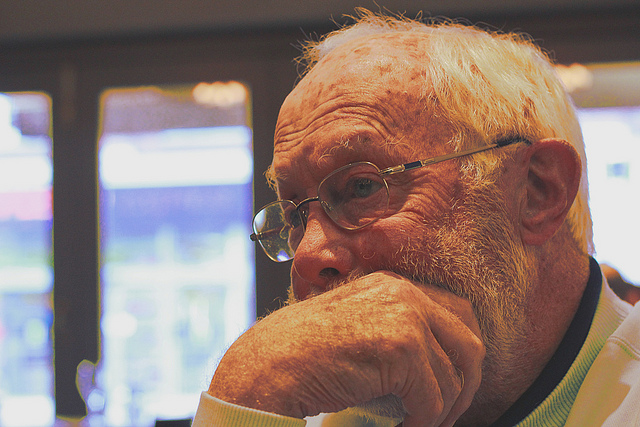
Siddie Nam – Thinking – CC BY-NC-ND 2.0.
In a series of ground-breaking studies conducted during the 1950s and 1960s, researchers started investigating how a speech’s organization was related to audience perceptions of those speeches. The first study, conducted by Raymond Smith in 1951, randomly organized the parts of a speech to see how audiences would react. Not surprisingly, when speeches were randomly organized, the audience perceived the speech more negatively than when audiences were presented with a speech with a clear, intentional organization. Smith also found that audiences who listened to unorganized speeches were less interested in those speeches than audiences who listened to organized speeches (Smith, 1951). Thompson furthered this investigation and found that it was harder for audiences to recall information after an unorganized speech. Basically, people remember information from speeches that are clearly organized, and they forget information from speeches that are poorly organized (Thompson, 1960). A third study by Baker found that when audiences were presented with a disorganized speaker, they were less likely to be persuaded, and saw the disorganized speaker as lacking credibility (Baker, 1965).
These three critical studies make the importance of organization very clear. When speakers are organized they are perceived as credible. When speakers are not organized, their audiences view the speeches negatively, are less likely to be persuaded, and don’t remember specific information from the speeches after the fact.
We start this chapter by discussing these studies because we want you to understand the importance of speech organization to real audiences. This chapter will help you learn organization so that your speech with have its intended effect. In this chapter, we are going to discuss the basics of organizing the body of your speech.
Determining Your Main Ideas
While speeches take many different forms, they are often discussed as having an introduction, a body, and a conclusion. The introduction establishes the topic and wets your audience’s appetite, and the conclusion wraps everything up at the end of your speech. The real “meat” of your speech happens in the body. In this section, we’re going to discuss how to think strategically about structuring the body of your speech.
We like the word strategic because it refers to determining what is essential to the overall plan or purpose of your speech. Too often, new speakers throw information together and stand up and start speaking. When that happens, audience members are left confused, and the reason for the speech may get lost. To avoid being seen as disorganized, we want you to start thinking critically about the organization of your speech. In this section, we will discuss how to take your speech from a specific purpose to creating the main points of your speech.
What Is Your Specific Purpose?
Before we discuss how to determine the main points of your speech, we want to revisit your speech’s specific purpose, which we discussed in detail in Chapter 4 “Topic, Purpose, and Thesis”. Recall that a speech can have one of three general purposes: to inform, to persuade, or to entertain. The general purpose refers to the broad goal for creating and delivering the speech. The specific purpose, on the other hand, starts with one of those broad goals (inform, persuade, or entertain) and then further informs the listener about the who , what , when , where , why , and how of the speech.
The specific purpose is stated as a sentence incorporating the general purpose, the specific audience for the speech, and a prepositional phrase that summarizes the topic. Suppose you are going to give a speech about using open-source software. Here are three examples (each with a different general purpose and a different audience):
In each of these three examples, you’ll notice that the general topic is the same, open-source software, but the specific purpose is different because the speech has a different general purpose and a different audience. Before you can think strategically about organizing the body of your speech, you need to know what your specific purpose is. If you have not yet written a specific purpose for your current speech, please go ahead and write one now.
From Specific Purpose to Main Points
Once you’ve written down your specific purpose, you can start thinking about the best way to turn that specific purpose into a series of main points. Main points are the key ideas you present to enable your speech to accomplish its specific purpose. In this section, we’re going to discuss how to determine your main points and how to organize those main points into a coherent, strategic speech.
Main Points are the key ideas you present to enable your speech to accomplish its specific purpose.
How Many Main Points Do I Need?
While there is no magic number for how many main points a speech should have, speech experts generally agree that the fewer the number of main points the better. First and foremost, experts on the subject of memory have consistently shown that people don’t tend to remember very much after they listen to a message or leave a conversation (Bostrom & Waldhart, 1988). While many different factors can affect a listener’s ability to retain information after a speech, how the speech is organized is an important part of that process (Dunham, 1964; Smith, 1951; Thompson, 1960). For the speeches you will be delivering in a typical public speaking class, you will usually have just two or three main points. If your speech is less than three minutes long, then two main points will probably work best. If your speech is between three and ten minutes in length, then it makes more sense to use three main points.
You may be wondering why we are recommending only two or three main points. The reason comes straight out of the research on listening. According to LeFrancois, people are more likely to remember information that is meaningful, useful, and of interest to them; different or unique; organized; visual; and simple (LeFrancois, 1999). Two or three main points are much easier for listeners to remember than ten or even five. In addition, if you have two or three main points, you’ll be able to develop each one with examples, statistics, or other forms of support. Including support for each point will make your speech more interesting and more memorable for your audience.
Narrowing Down Your Main Points
When you write your specific purpose and review the research you have done on your topic, you will probably find yourself thinking of quite a few points that you’d like to make in your speech. Whether that’s the case or not, we recommend taking a few minutes to brainstorm and develop a list of points. In brainstorming, your goal is simply to think of as many different points as you can, not to judge how valuable or vital they are. What information does your audience need to know to understand your topic? What information does your speech need to convey to accomplish its specific purpose? Consider the following example:
Now that you have brainstormed and developed a list of possible points, how do you go about narrowing them down to just two or three main ones? Remember, your main points are the key ideas that help build your speech. When you look over the preceding list, you can then start to see that many of the points are related to one another. Your goal in narrowing down your main points is to identify which individual, potentially minor points can be combined to make main points. This process is called chunking because it involves taking smaller chunks of information and putting them together with like chunks to create more fully developed chunks of information. Before reading our chunking of the preceding list, see if you can determine three large chunks out of the list (note that not all chunks are equal).
Chunking involves taking smaller chunks of information and putting them together with like chunks to create more fully developed chunks of information.
You may notice that in the preceding list, the number of subpoints under each of the three main points is a little disjointed or the topics don’t go together clearly. That’s all right. Remember that these are just general ideas at this point. It’s also important to remember that there is often more than one way to organize a speech. Some of these points could be left out and others developed more fully, depending on the purpose and audience. We’ll develop the preceding main points more fully in a moment.
Helpful Hints for Preparing Your Main Points
Now that we’ve discussed how to take a specific purpose and turn it into a series of main points, here are some helpful hints for creating your main points.
Uniting Your Main Points
Once you’ve generated a possible list of main points, you want to ask yourself this question: “When you look at your main points, do they fit together?” For example, if you look at the three preceding main points (school districts use software in their operations; what is open-source software; name some specific open-source software packages that may be appropriate for these school administrators to consider), ask yourself, “Do these main points help my audience understand my specific purpose?”
Suppose you added a fourth main point about open-source software for musicians—would this fourth main point go with the other three? Probably not. While you may have a strong passion for open-source music software, that main point is extraneous information for the speech you are giving. It does not help accomplish your specific purpose, so you’d need to toss it out.
Keeping Your Main Points Separate
The next question to ask yourself about your main points is whether they overlap too much. While some overlap may happen naturally because of the singular nature of a specific topic, the information covered within each main point should be clearly distinct from the other main points. Imagine you’re giving a speech with the specific purpose “to inform my audience about the health reasons for eating apples and oranges.” You could then have three main points: that eating fruits is healthy, that eating apples is healthy, and that eating oranges is healthy. While the two points related to apples and oranges are clearly distinct, both of those main points would probably overlap too much with the first point “that eating fruits is healthy,” so you would probably decide to eliminate the first point and focus on the second and third. On the other hand, you could keep the first point and then develop two new points giving additional support to why people should eat fruit.
Balancing Main Points
One of the biggest mistakes some speakers make is to spend most of their time talking about one of their main points, completely neglecting their other main points. To avoid this mistake, organize your speech to spend roughly the same amount of time on each main point. If you find that one of your main points is simply too large, you may need to divide that main point into two main points and consolidate your other main points into a single main point.
Let’s see if our preceding example is balanced (school districts use software in their operations; what is open-source software; name some specific open-source software packages that may be appropriate for these school administrators to consider). What do you think? The answer depends on how much time a speaker will have to talk about each of these main points. If you have an hour to speak, then you may find that these three main points are balanced. However, you may also find them wildly unbalanced if you only have five minutes to speak because five minutes is not enough time to even explain what open-source software is. If that’s the case, then you probably need to rethink your specific purpose to ensure that you can cover the material in the allotted time.
Creating Parallel Structure for Main Points
Another major question to ask yourself about your main points is whether or not they have a parallel structure. By parallel structure , we mean that you should structure your main points so that they all sound similar. When all your main points sound similar, it’s easier for your audiences to remember your main points and retain them for later. Let’s look at our sample (school districts use software in their operations; what is open-source software; name some specific open-source software packages that may be appropriate for these school administrators to consider). Notice that the first and third main points are statements, but the second one is a question. We have an example here of main points that are not parallel in structure. You could fix this in one of two ways. You could make them all questions: what are some common school district software programs; what is open-source software; and what are some specific open-source software packages that may be appropriate for these school administrators to consider. Or you could turn them all into statements: school districts use software in their operations; define and describe open-source software; name some specific open-source software packages that may be appropriate for these school administrators to consider. Either of these changes will make the grammatical structure of the main points parallel.
Parallel structure means structuring your main points so that they all sound similar.
Maintaining Logical Flow of Main Points
The last question you want to ask yourself about your main points is whether the main points make sense in the order you’ve placed them. The next section goes into more detail of common organizational patterns for speeches, but for now, we want you to think logically about the flow of your main points. When you look at your main points, can you see them as progressive, or does it make sense to talk about one first, another one second, and the final one last? If you look at your order, and it doesn’t make sense to you, you probably need to think about the flow of your main points. Often, this process is an art and not a science. But let’s look at a couple of examples.
When you look at these two examples, what are your immediate impressions of the two examples? In the first example, does it make sense to talk about history, and then the problems, and finally how to eliminate school dress codes? Would it make sense to put history as your last main point? Probably not. In this case, the main points are in a logical sequential order. What about the second example? Does it make sense to talk about your solution, then your problem, and then define the solution? Not really! What order do you think these main points should be placed in for a logical flow? Maybe you should explain the problem (lack of rider laws), then define your solution (what is rider law legislation), and then argue for your solution (why states should have rider laws). Notice that in this example you don’t even need to know what “rider laws” are to see that the flow didn’t make sense.
Using Common Organizing Patterns

Twentyfour Students – Organization makes you flow – CC BY-SA 2.0.
Previously in this chapter, we discussed how to make your main points flow logically. This section is going to provide you with organization patterns to help you create a logically organized speech. The first organization pattern we’ll discuss is categorical/topical.
Categorical/Topical
By far the most common pattern for organizing a speech is by categories or topics. The categories function as a way to help the speaker organize the message in a consistent fashion. The goal of a categorical/topical speech pattern is to create categories (or chunks) of information that go together to help support your original specific purpose. Let’s look at an example:
In this case, we have a speaker trying to persuade a group of high school juniors to apply to attend Generic University. To persuade this group, the speaker has divided the information into three basic categories: what it’s like to live in the dorms, what classes are like, and what life is like on campus. Almost anyone could take this basic speech and specifically tailor the speech to fit their own university or college. The main points in this example could be rearranged and the organizational pattern would still be effective because there is no inherent logic to the sequence of points. Let’s look at a second example:
In this speech, the speaker is talking about how to find others online and date them. Specifically, the speaker starts by explaining what Internet dating is; then the speaker talks about how to make Internet dating better for her or his audience members; and finally, the speaker ends by discussing some negative aspects of Internet dating. Again, notice that the information is chunked into three categories or topics and that the second and third could be reversed and still provide a logical structure for your speech.
Comparison/Contrast
Another method for organizing your main points is the comparison/contrast speech pattern . While this pattern lends itself easily to two main points, you can also create a third point by giving basic information about what is being compared and what is being contrasted. Let’s look at two examples; the first one will be a two-point example and the second a three-point example:
If you were using the comparison/contrast pattern for persuasive purposes, in the preceding examples, you’d want to make sure that when you show how Drug X and Drug Y differ, you clearly state why Drug X is the better choice for physicians to adopt. In essence, you’d want to make sure that when you compare the two drugs, you show that Drug X has all the benefits of Drug Y, but when you contrast the two drugs, you show how Drug X is superior to Drug Y in some way.
The spatial speech pattern organizes information according to how things fit together in physical space. This pattern is best used when your main points are oriented to different locations that can exist independently. The primary reason to choose this format is to show that the main points have specific locations. We’ll look at two examples here, one involving physical geography and one involving a different spatial order.
If you look at a basic map of the United States, you’ll notice that these groupings of states were created because of their geographic location to one another. In essence, the states create three spatial territories to explain.
Now let’s look at a spatial speech unrelated to geography.
In this example, we still have three spatial areas. If you look at a model of the urinary system, the first step is the kidney, which then takes waste through the ureters to the bladder, which then relies on the sphincter muscle to excrete waste through the urethra. All we’ve done in this example is create a spatial speech order for discussing how waste is removed from the human body through the urinary system. It is spatial because the organization pattern is determined by the physical location of each body part in relation to the others discussed.
Chronological
The chronological speech pattern places the main idea in the time order in which items appear—whether backward or forward. Here’s a simple example.
In this example, we’re looking at the writings of Winston Churchill in relation to World War II (before, during, and after). By placing his writings into these three categories, we develop a system for understanding this material based on Churchill’s own life. Note that you could also use reverse chronological order and start with Churchill’s writings after World War II, progressing backward to his earliest writings.
Cause/Effect
The causal speech pattern is used to explain cause-and-effect relationships. When you use a causal speech pattern, your speech will have two basic main points: cause and effect. In the first main point, typically you will talk about the causes of a phenomenon, and in the second main point, you will then show how the causes lead to either a specific effect or a small set of effects. Let’s look at an example.
In this case, the first main point is about the history and prevalence of drinking alcohol among Native Americans (the cause). The second point then examines the effects of Native American alcohol consumption and how it differs from other population groups.
However, a causal organizational pattern can also begin with an effect and then explore one or more causes. In the following example, the effect is the number of arrests for domestic violence.
In this example, the possible causes for the difference might include stricter law enforcement, greater likelihood of neighbors reporting an incident, and police training that emphasizes arrests as opposed to other outcomes. Examining these possible causes may suggest that despite the arrest statistic, the actual number of domestic violence incidents in your city may not be greater than in other cities of similar size.
Problem-Cause-Solution
Another format for organizing distinct main points in a clear manner is the problem-cause-solution speech pattern . In this format, you describe a problem, identify what you believe is causing the problem, and then recommend a solution to correct the problem.
In this speech, the speaker wants to persuade people to pass a new curfew for people under eighteen. To help persuade the civic group members, the speaker first shows that vandalism and violence are problems in the community. Once the speaker has demonstrated the problem, the speaker then explains to the audience that the cause of this problem is youth outside after 10:00 p.m. Lastly, the speaker provides the mandatory 10:00 p.m. curfew as a solution to the vandalism and violence problem within the community. The problem-cause-solution format for speeches generally lends itself to persuasive topics because the speaker is asking an audience to believe in and adopt a specific solution.
Speech Pattern Overview
The categorical/topical speech pattern creates categories (or chunks) of information that go together to help support your original specific purpose.
The comparison/contrast speech pattern uses main points to compare an contrast two similar objects, topics, or ideas.
The spatial speech pattern organizes information according to how things fit together in physical space.
The chronological speech pattern places the main idea in the time order in which items appear—whether backward or forward.
The causal speech pattern is used to explain cause-and-effect relationships. When you use a causal speech pattern, your speech will have two basic main points: cause and effect.
The problem-cause-solution speech pattern describes a problem, identifies what is causing the problem, and then recommends a solution to correct the problem.
Selecting an Organizational Pattern
Each of the preceding organizational patterns is potentially useful for organizing the main points of your speech. However, not all organizational patterns work for all speeches. For example, as we mentioned earlier, the biographical pattern is useful when you are telling the story of someone’s life. Some other patterns, particularly comparison/contrast, problem-cause-solution, and psychological, are well suited for persuasive speaking. Your challenge is to choose the best pattern for the particular speech you are giving.
You will want to be aware that it is also possible to combine two or more organizational patterns to meet the goals of a specific speech. For example, you might wish to discuss a problem and then compare/contrast several different possible solutions for the audience. Such a speech would thus be combining elements of the comparison/contrast and problem-cause-solution patterns. When considering which organizational pattern to use, you need to keep in mind your specific purpose as well as your audience and the actual speech material itself to decide which pattern you think will work best.
Keeping Your Speech Moving

Chris Marquardt – REWIND – CC BY-SA 2.0.
Have you ever been listening to a speech or a lecture and found yourself thinking, “I am so lost!” or “Where the heck is this speaker going?” Chances are one of the reasons you weren’t sure what the speaker was talking about was that the speaker didn’t effectively keep the speech moving. When we are reading and encounter something we don’t understand, we can reread the paragraph and try to make sense of what we’re trying to read. Unfortunately, we are not that lucky when it comes to listening to a speaker. We cannot pick up our universal remote and rewind the person. For this reason, speakers need to think about how they keep a speech moving so that audience members are easily able to keep up with the speech. In this section, we’re going to look at four specific techniques speakers can use that make following a speech much easier for an audience: transitions, internal previews, internal summaries, and signposts.
Transitions between Main Points
A transition is a phrase or sentence that indicates that a speaker is moving from one main point to another main point in a speech. Basically, a transition is a sentence where the speaker summarizes what was said in one point and previews what is going to be discussed in the next point. Let’s look at some examples:
- Now that we’ve seen the problems caused by lack of adolescent curfew laws, let’s examine how curfew laws could benefit our community.
- Thus far we’ve examined the history and prevalence of alcohol abuse among Native Americans, but it is the impact that this abuse has on the health of Native Americans that is of the greatest concern.
- Now that we’ve thoroughly examined how these two medications are similar to one another, we can consider the many clear differences between the two medications.
- Although he was one of the most prolific writers in Great Britain prior to World War II, Winston Churchill continued to publish during the war years as well.
You’ll notice that in each of these transition examples, the beginning phrase of the sentence indicates the conclusion of a period of time (now that, thus far) or main point. Table 2: Transition Words contains a variety of transition words that will be useful when keeping your speech moving.
Table 2: Transition Words
Beyond transitions, there are several other techniques that you can use to clarify your speech organization for your audience. The next sections address several of these techniques, including internal previews, internal summaries, and signposts.
Internal Previews
An internal preview is a phrase or sentence that gives an audience an idea of what is to come within a section of a speech. An internal preview works similarly to the preview that a speaker gives at the end of a speech introduction, quickly outlining what he or she is going to talk about (i.e. the speech’s three main body points). In an internal preview, the speaker highlights what he or she is going to discuss within a specific main point during a speech.
Ausubel was the first person to examine the effect that internal previews had on retention of oral information (Ausubel, 1968). When a speaker clearly informs an audience what they are going to be talking about in a clear and organized manner, the audience listens for those main points, which leads to higher retention of the speaker’s message. Let’s look at a sample internal preview:
To help us further understand why recycling is important, we will first explain the positive benefits of recycling and then explore how recycling can help our community.
When an audience hears that you will be exploring two different ideas within this main point, they are ready to listen for those main points as you talk about them. In essence, you’re helping your audience keep up with your speech.
Rather than being given alone, internal previews often come after a speaker has transitioned to that main topic area. Using the previous internal preview, let’s see it along with the transition to that main point.
Now that we’ve explored the effect that a lack of consistent recycling has on our community, let’s explore the importance of recycling for our community (transition). To help us further understand why recycling is important, we will first explain the positive benefits of recycling and then explore how recycling can help our community (internal preview).
While internal previews are definitely helpful, you do not need to include one for every main point of your speech. In fact, we recommend that you use internal previews sparingly to highlight only the main points containing relatively complex information.
Internal Summaries
Whereas an internal preview helps an audience know what you are going to talk about within a main point at the beginning, an internal summary is delivered to remind an audience of what they just heard within the speech. In general, internal summaries are best used when the information within a specific main point of a speech was complicated. To write your own internal summaries, look at the summarizing transition words in Table 2: Transition Words Let’s look at an example.
To sum up, school bullying is a definite problem. Bullying in schools has been shown to be detrimental to the victim’s grades, the victim’s scores on standardized tests, and the victim’s future educational outlook.
In this example, the speaker was probably talking about the impact that bullying has on an individual victim educationally. Of course, an internal summary can also be a great way to lead into a transition to the next point of a speech.
In this section, we have explored how bullying in schools has been shown to be detrimental to the victim’s grades, the victim’s scores on standardized tests, and the victim’s future educational outlook (internal summary). Therefore, schools need to implement campus-wide, comprehensive anti-bullying programs (transition).
While not sounding like the more traditional transition, this internal summary helps readers summarize the content of that main point. The sentence that follows than leads to the next major part of the speech, which is going to discuss the importance of anti-bullying programs.
Have you ever been on a road trip and watched the green rectangular mile signs pass you by? Fifty miles to go. Twenty-five miles to go. One mile to go. Signposts within a speech function the same way. A signpost is a guide a speaker gives their audience to help the audience keep up with the content of a speech. If you look at Table 2: Transition Words and look at the “common sequence patterns,” you’ll see a series of possible signpost options. In essence, we use these short phrases at the beginning of a piece of information to help our audience members keep up with what we’re discussing. For example, if you were giving a speech whose main point was about the three functions of credibility, you could use internal signposts like this:
- The first function of credibility is competence.
- The second function of credibility is trustworthiness.
- The final function of credibility is caring/goodwill.
Signposts are meant to help your audience keep up with your speech, so the more simplistic your signposts are, the easier it is for your audience to follow.
In addition to helping audience members keep up with a speech, signposts can also be used to highlight specific information the speaker thinks is important. Where the other signposts were designed to show the way (like highway markers), signposts that call attention to specific pieces of information are more like billboards. Words and phrases that are useful for highlighting information can be found in Table 2: Transition Words under the category “emphasis.” All these words are designed to help you call attention to what you are saying so that the audience will also recognize the importance of the information.
A transition is a phrase or sentence that indicates that a speaker is moving from one main point to another main point in a speech.
An internal preview is a phrase or sentence that gives an audience an idea of what is to come within a section of a speech.
An internal summary is delivered to remind an audience of what they just heard within the speech.
A signpost is a guide a speaker gives their audience to help the audience keep up with the content of a speech.
Ausubel, D. P. (1968). Educational psychology . New York, NY: Holt, Rinehart, & Winston.
Baker, E. E. (1965). The immediate effects of perceived speaker disorganization on speaker credibility and audience attitude change in persuasive speaking. Western Speech, 29 , 148–161.
Bostrom, R. N., & Waldhart, E. S. (1988). Memory models and the measurement of listening. Communication Education, 37 , 1–13.
Dunham, J. R. (1964). Voice contrast and repetition in speech retention (Doctoral dissertation). Retrieved from: http://etd.lib.ttu.edu/theses .
LeFrancois, G. R. (1999). Psychology for teaching (10th ed.). Belmont, CA: Wadsworth.
Smith, R. G. (1951). An experimental study of the effects of speech organization upon attitudes of college students. Speech Monographs, 18 , 292–301.
Thompson, E. C. (1960). An experimental investigation of the relative effectiveness of organizational structure in oral communication. Southern Speech Journal, 26 , 59–69.
Stand up, Speak out Copyright © 2017 by Josh Miller; Marnie Lawler-Mcdonough; Megan Orcholski; Kristin Woodward; Lisa Roth; and Emily Mueller is licensed under a Creative Commons Attribution-NonCommercial-ShareAlike 4.0 International License , except where otherwise noted.
Share This Book

As a speechwriter at the National Air and Space Museum, I have always been fascinated by looking at great moments in history through the lens of the speeches that were delivered to rousing applause, somber contemplation, or something in between. So, with the 50th anniversary of the first Moon landing upon us, it is interesting to look at the speeches that led to that moment.
The Soviet Union launched the first human, Yuri Gagarin, into space on April 12, 1961, beating both Alan Shepard to space and John Glenn to orbit. Within days of the Soviet achievement, President John F. Kennedy asked Vice President Lyndon Johnson to identify a “space program which promises dramatic results in which we could win.” A little over a month later, on May 25, 1961, Kennedy stood before a joint session of Congress and called for human exploration to the Moon. Unlike his later speech at Rice University, Kennedy’s address to Congress isn’t soaring rhetoric about the excitement about exploration or the significance of humanity’s first steps on the Moon. Rather, it was about why it was important that the first steps on the Moon be those of an American. He discusses the Apollo Moonshot as an important step to “win the battle that is now going on around the world between freedom and tyranny.” Moments later he declared: It is “time to take longer strides – time for a great new American enterprise –time for this nation to take a clearly leading role in space achievement, which in many ways may hold the key to our future on earth.”
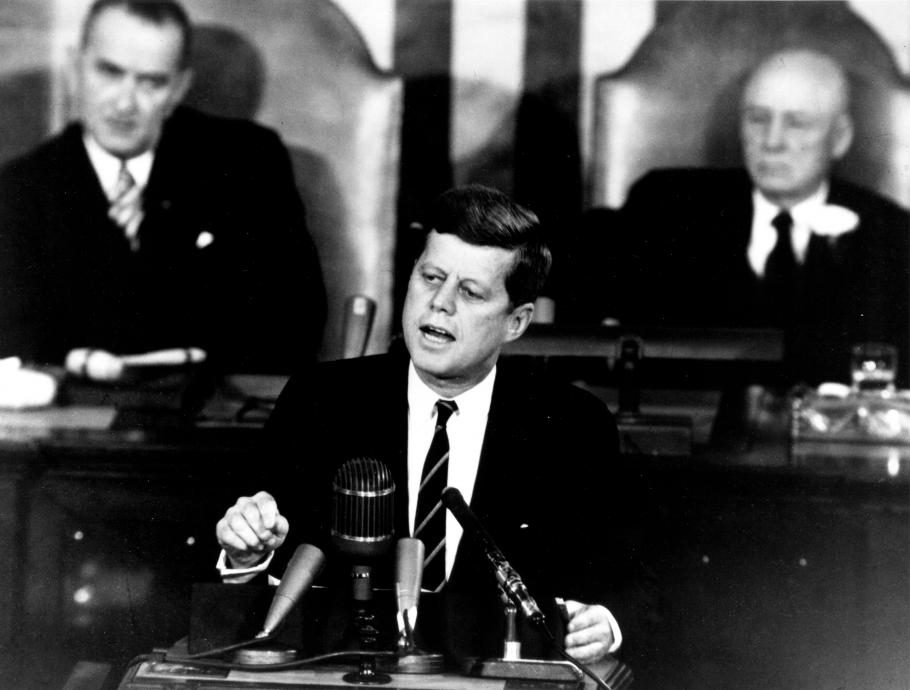
The speech then laid out the path forward, should the United States embark on this journey. Achieving this goal will require the efforts of all Americans and an expense of billions of dollars. Kennedy put forth the risk and the reward, and called upon Congress to make the decision once and for all, on behalf of the American public:
“I believe we should go to the moon. But I think every citizen of this country as well as the Members of the Congress should consider the matter carefully in making their judgment, to which we have given attention over many weeks and months, because it is a heavy burden, and there is no sense in agreeing or desiring that the United States take an affirmative position in outer space, unless we are prepared to do the work and bear the burdens to make it successful. If we are not, we should decide today and this year.”
And the decision was made: go for the Moon. Following Kennedy’s address, NASA’s budget increased by 89 percent, and then by another 101 percent the following year. The race for the Moon was on.
(It is important to note that at the time this speech was delivered, NASA was still months away from even orbiting an astronaut. A recent blog by space history curator Michael Neufeld recounts the reaction of one NASA leader to the address: “Even through Gilruth had been part of the consultations, he was “aghast” when he heard the speech, as he contemplated such an ambitious schedule.”)
With the decision made, Kennedy now had to rally the support of the American public – after all, this was the most expensive civilian technological program in U.S. history. On September 12, 1962, he delivered his famous “We Choose to Go to the Moon” speech in front of a crowd of 40,000 at Rice University in Texas. In many ways, this speech is a masterclass in speechwriting, with its vivid pictures and soaring metaphors. Kennedy skillfully uses repetition to draw the audience in and capture the importance and urgency of the matter at hand.
“But why, some say, the moon?” he posed. “Why choose this as our goal? And they may well ask why climb the highest mountain? Why, 35 years ago, fly the Atlantic? Why does Rice play Texas? We choose to go to the moon. We choose to go to the moon in this decade and do the other things, not because they are easy, but because they are hard, because that goal will serve to organize and measure the best of our energies and skills, because that challenge is one that we are willing to accept, one we are unwilling to postpone, and one which we intend to win, and the others, too.”
(JFK also knew how to play to his audience. Handwritten notes by Kennedy show that the “Why does Rice play Texas?” line was added last minute. It naturally drew great applause.)

And at the end of the speech, Kennedy returned to one of the questions he posed earlier with a short anecdote to inspire the crowd and frame the quest for the Moon as an imperative: “Many years ago the great British explorer George Mallory, who was to die on Mount Everest, was asked why did he want to climb it. He said, "Because it is there."”
The Moon was there, and it was a challenge America was ready to accept and ready to win.
But speeches aren’t just used to rally public support. They also play an important role when responding to tragedy. And it was a somber reality that the Apollo 11 astronaut’s return from the Moon wasn’t a complete certainty.
When Kennedy stood before Congress to lay out the Apollo Moonshot, he didn’t just speak of landing on the Moon. The goal, he articulated, was of “landing a man on the Moon and returning him safely to Earth.”
So in 1969, as President Richard Nixon’s speechwriters prepared his congratulatory remarks for the Apollo 11 mission, another speech was written in tandem. This additional set of remarks are of the sort that a speechwriter knows could be of utmost importance, but hopes will never need to see the light of day: what Nixon would say if Neil Armstrong and Buzz Aldrin did not return from the Moon. The speech was sent in a memo from Nixon speechwriter Bill Safire to White House Chief of Staff H.R. Haldeman, titled “In Event of Moon Disaster.”
The resulting speech is short and hauntingly beautiful. “Fate has ordained that the men who went to the moon to explore in peace will stay on the moon to rest in peace,” it begins.
In the month before the Apollo 11 launch, Apollo 8 astronaut and NASA liaison Frank Borman spoke with Safire, recommending that the West Wing be prepared in case there were problems during the lunar landing: “You’ll want to consider an alternative posture for the president in the event of mishaps.” The speech does just that: it is written in the event that Armstrong and Aldrin were stranded on the Moon. It captures the real concerns and danger that can exist when doing what once seemed impossible.
From a personal standpoint, I was not alive during the Moon landing. I have never known a time when we hadn’t gone to the Moon or weren’t regularly sending humans into space. So for me, the existence of this speech is a stark reminder of the incredible courage it takes to launch into space on a rocket and go where no person has gone before. And it reminds me not to take for granted this incredible thing 400,000 hard-working Americans accomplished together.
The speech is printed in full below.
Fate has ordained that the men who went to the moon to explore in peace will stay on the moon to rest in peace. These brave men, Neil Armstrong and Edwin Aldrin, know that there is no hope for their recovery. But they also know that there is hope for mankind in their sacrifice. These two men are laying down their lives in mankind's most noble goal: the search for truth and understanding. They will be mourned by their families and friends; they will be mourned by their nation; they will be mourned by the people of the world; they will be mourned by a Mother Earth that dared send two of her sons into the unknown. In their exploration, they stirred the people of the world to feel as one; in their sacrifice, they bind more tightly the brotherhood of man. In ancient days, men looked at stars and saw their heroes in the constellations. In modern times, we do much the same, but our heroes are epic men of flesh and blood. Others will follow, and surely find their way home. Man's search will not be denied. But these men were the first, and they will remain the foremost in our hearts. For every human being who looks up at the moon in the nights to come will know that there is some corner of another world that is forever mankind.
The original Safire Memo is in the National Archives .
We rely on the generous support of donors, sponsors, members, and other benefactors to share the history and impact of aviation and spaceflight, educate the public, and inspire future generations. With your help, we can continue to preserve and safeguard the world’s most comprehensive collection of artifacts representing the great achievements of flight and space exploration.
- Get Involved
- Host an Event
Thank you. You have successfully signed up for our newsletter.
Error message, sorry, there was a problem. please ensure your details are valid and try again..
- Free Timed-Entry Passes Required
- Terms of Use
Voice At The Table
Diversity & Inclusion Strategy
7 Tips for Creating Safe Spaces for Speaking Out

By Inge Woudstra
Today, I want to share 7 tips on how to create a space where people feel safe to share, as part of a meeting, training programme or workshop. These tips will help to ensure that people feel encouraged not only to share but also to disagree and be disagreed with, and know it’s okay to get it wrong.
- Share an agenda upfront
Some people thrive thinking on their feet, while others prefer to have time to reflect and prepare. Sharing an agenda upfront allows people with either thinking style to feel comfortable.
- Agree on the purpose of the conversation or meeting
When people know the purpose, they find it easier to contribute. Examples of the purpose of a meeting could include: ‘gather ideas’, ‘explore the pros and cons of a wide range of options’ or ‘decide which action to take’. This can be included in the agenda, in the form of a question for each agenda item. For instance, ‘What action should we take in order to achieve…? Discussion’.
- Set ground rules that encourage psychological safety
When we agree ground rules at the start of a meeting or conversation, we set expectations and keep lines of communication open. Effective ground rules help to build trust and a sense of safety among a group of participants.
Ground rules can be set by the meeting chair, or can be developed by the group. For example, the rules could include:
- Listen to others, and refrain from side conversations
- Respect others’ views; we all have the right to an opinion
- Ask for clarification before sharing your opinion
- Speak up when something is unclear or you would like more information
- Be concise, to allow everyone time to speak
- Keep an open mind and listen with curiosity
- Feel free to share what has been said in this meeting, but don’t reveal the identity or the affiliation of the speaker(s), or that of any other participant (Chatham House Rule).
- Let people finish
When we give someone space to finish their thoughts, it allows them to fully develop their thinking. It also allows those listening to fully understand where someone is coming from. In contrast, when we interrupt someone we may miss a key insight or conclusion. Moreover, the speaker hasn’t been able to finish their train of thought and will then usually find it harder to listen to others, and may well feel disrespected or undervalued.
As a meeting chair, we would need to speak up when we hear someone isn’t allowed to finish. Last week we shared some tips on how to speak up in a respectful way .
- Appreciate contributions
Listen with curiosity and attention, as that gives people the feeling their contribution is appreciated. That in turn means they will be more likely to speak up and contribute next time. Even if we disagree with someone, or will not use their idea, we need to listen with curiosity and attention. Afterwards, we may acknowledge the fact the person has contributed, and let them know what will happen with their idea.
When we are in a position of authority, or have an informal position of influence, others will wait for our input and will be inclined to align their opinion with ours. Therefore, it’s important we are aware of our own position in a group and take care to speak last when possible.
- Encourage positivity
It’s easy to get stuck in negativity. When evaluating a situation or an idea, we tend to focus on what isn’t working. When listening to an idea, we often only see its downsides and why the idea may not work. If you notice this in meetings, unlock positive thinking by asking questions such as, ‘What is already working?’, ‘What could we do to solve this issue?’, ‘If we do this, what would we need to do to make it work?’ or ‘What is already going well?’
Following these tips will make it easier for people to open up and to contribute with their inner thoughts, without fear of repercussions. They will therefore facilitate an inclusive environment where everyone can speak out, and the group will benefit from a wider range of contributions.
If you are looking to learn more about creating safe spaces for your team, why not contact us for a no-obligation chat?
How to make it work for you!
Join us if you'd like to take meaningful steps towards creating environments where every voice is heard and valued, including your own.

87 episodes
Looking for some fresh ideas for your speech therapy sessions? The Speech Space podcast is a podcast full of tips and resources for speech-language pathologists working in the schools or private practice.
The Speech Space Podcast Jessica Cassity, M.S., CCC-SLP
- 4.8 • 112 Ratings
- APR 16, 2024
Neurodiversity-Affirming Speech Therapy
This episode is about neurodiversity-affirming speech therapy. I review the basic terminology of the neurodiversity paradigm, and explain what inspired the creation of this episode. I acknowledge the concerns that some SLPs have about the neurodiversity movement, and share why I’m excited to be a neurodiversity-affirming SLP. I also offer my favorite idea for getting started with neurodiversity-affirming speech therapy.
- APR 2, 2024
Using Music to Support Speech and Language
This episode is about using music to support speech and language skills in our speech therapy sessions. I introduce some of the research that supports connections between music and learning, and then provide a variety of practical ideas for how to use music in speech therapy with both older and younger students. The episode concludes with a brief exploration of how music is experienced in the Deaf community. The show notes from this episode can be accessed here:
- MAR 19, 2024
Spring-themed Speech Therapy Ideas
This episode is about ideas for spring-themed speech therapy sessions. I discuss how to use nature in spring-themed speech therapy sessions, including observing the weather, going on nature walks, and planting seeds. I include options for adapting these ideas for different contexts, including teletherapy. I also share spring-themed picture book recommendations, and ideas for spring-themed speech therapy sessions with middle school and high school students. The show notes from this episode can be accessed here:
- MAR 5, 2024
Trauma-Informed Speech Therapy
This episode focuses on the important role that SLPs can play in helping their students and clients feel safe and ready to learn. I review basic information about trauma, and then cover topics related to trauma-informed speech therapy. The episode includes an explanation of the principles of trauma-informed care, and practical suggestions for how to put them into practice during your speech therapy sessions. The show notes from this episode can be accessed here:
- FEB 20, 2024
How to Be an Anti-ableist SLP
This episode discusses how to be an anti-ableist SLP. In the episode, I talk about the importance of recognizing ableism's influence, and then actively pushing back against it by using inclusive language, being thoughtful about our goal choices, supporting accessibility for disabled SLPs, and addressing ableist microaggressions. Go here to access the show notes ==> https://www.thedigitalslp.com/podcast/how-to-be-an-anti-ableist-slp/
- FEB 6, 2024
New Perspectives on Stuttering - Part 2
This episode is all about new perspectives on stuttering and it's the second half of a 2-part series. Make sure to listen to part one first so it all comes together. In this episode, I address topics like stuttering gain, concepts of stutter-affirming therapy, key elements of effective self-disclosure, and intersectionality. The show notes from this episode can be accessed here: https://bit.ly/TSSEP126
Customer Reviews
112 Ratings
Thoughtful, Concise, and research-based tips!
I love this podcast because it’s straightforward information presented without the fluff (because who has time for all the fluff?)! I really appreciate the topics chosen because they are all very relevant to my practice the public schools.
Fantastic Information & Materials!!!
I use and enjoy your podcast and The Digital SLP materials everyday as a school SLP. You and your absolutely amazing digital materials make me a more efficient and effect SLP. Thank you!!
ES 96 Best Back to School Tips for SLPS
As a mindful SLP that implements awareness and compassion-based practices into my personal and professional life, this episode really calls out to me on the Speech Space Podcast. Jessica shares her values and easily provides 3- quick golden nuggets that speech clinicians can implement into their day, from the start of the school year, which provide more ease and well-being. Thank you, Jessica.
Top Podcasts In Education
You might also like.
The Throughline Blog
Practical Media Training and Public Speaking Tips
Verbal White Space: The Importance Of Pausing
I recently helped a client prepare for a major speech at his company’s annual conference.
Before we met, he created a thoughtful presentation highlighting 20 terrific marketing ideas. Since he only had an hour for his talk, he knew he’d have to rush through the material and eliminate audience questions.
As I watched him practice his speech, it became clear to me that his ideas weren’t landing with the impact they deserved. Although the ideas were great, his rapid-fire delivery wasn’t allowing his audience enough time to fully engage with his ideas.
I told him about the graphic design concept of white space, described on Wikipedia as a principle of design that gives the eye a “place to rest,” thus increasing the appeal of a composition through subtle means.
The same concept applies to public speaking. Verbal white space – or a short pause – allows the audience to process your ideas on their terms, meaning you’ve effectively transferred information from speaker to audience. Verbal white space also helps separate ideas from one another, preventing your audience from perceiving 20 distinct ideas as one giant one.
In addition, I suggested that my client break his talk into two breakout sessions. The first might focus on “10 Essential Marketing Ideas,” the second on “10 Advanced Marketing Ideas.” Fewer points, delivered with more verbal white space, have greater impact.
Dividing his talk into two halves would also allow plenty of time for questions, increasing the likelihood that his audience personally engages with his content.
Next time you give a speech, think about the major parts of your talk. Between each one, force yourself to pause for at least two seconds. It may feel like a lifetime to you, but your audience won’t notice. They’ll be far too busy thinking about what you’ve just said.
- presentation training
- verbal white space
Share this article
- Share on Facebook
- Share on Twitter
- Share on LinkedIn
- Share on Email
STAY UP TO DATE WITH THE THROUGHLINE NEWSLETTER
Join the thousands of professionals who receive our email newsletter. Improve your public speaking and media interviewing skills—and enhance your career— by signing up.

Public Speaking Skills Training
Since 2004, we have helped speakers prepare for the world’s biggest stages, including TED, the World Economic Forum, and a presidential announcement speech. We’re committed to your long-term growth, and we’ll be with you every step of the way.
Comments (2)
So true! Love the parallel with design’s white space. Great tip!
Daniela – thank you for the nice words! I’m proud of this article, since I seem to be the first person to think of “verbal white space” in this context. I hope it helps people remember to pause while speaking!
More from the throughline blog

In Presentation Training How to Hide a Lavalier Mic Wire

In Presentation Training Are Your Stories Making You Appear Inauthentic?

In Presentation Training Why You Should Have Three Speech Opens
This website or its third party tools use cookies, which are necessary to its functioning and required to achieve the purposes illustrated in the privacy policy . If you want to know more or withdraw your consent to all or some of the cookies, please refer to the privacy policy. By closing this banner or continuing to browse otherwise, you agree to the use of cookies.
Historic Speeches
Address at rice university on the nation's space effort.
Downloading Tip: If clicking the link above opens the file in your browser, it may help to hold the "Alt" or "Option" key when clicking on the link. Alternatively, you can right-click and select "Save Link As" to download this file.
Transcripts: [[selectable_languages.length]] Languages
About Historic Speech
Digital Identifier: USG-15-29-2
Title: Rice University, 12 September 1962
Date(s) of Materials: 12 September 1962
Description: Video of the National Aeronautic Space Administration's (NASA) coverage of President John F. Kennedy’s address at Rice University, Houston, Texas, concerning the nation's efforts in space exploration. In his speech the President discusses the necessity for the United States to become an international leader in space exploration and famously states, "We choose to go to the Moon in this decade and do the other things, not because they are easy, but because they are hard."
Copyright Status: Public Domain
Physical Description: Item 2 of 2 on 1 Video Cassette (color; sound; Beta-SP; 19 minutes)
[[selectable_languages.length]] Languages
A collection of TED Talks (and more) on the topic of Space.
Video playlists about Space

Curator's Picks: Top 10 TED Talks of 2018

The most popular TED Talks of 2018

The mystery and wonder of stars

What would it be like to live on another planet?
Talks about space.

The Nazis recruited to win the Cold War

The aboriginal knowledge stored in the stars
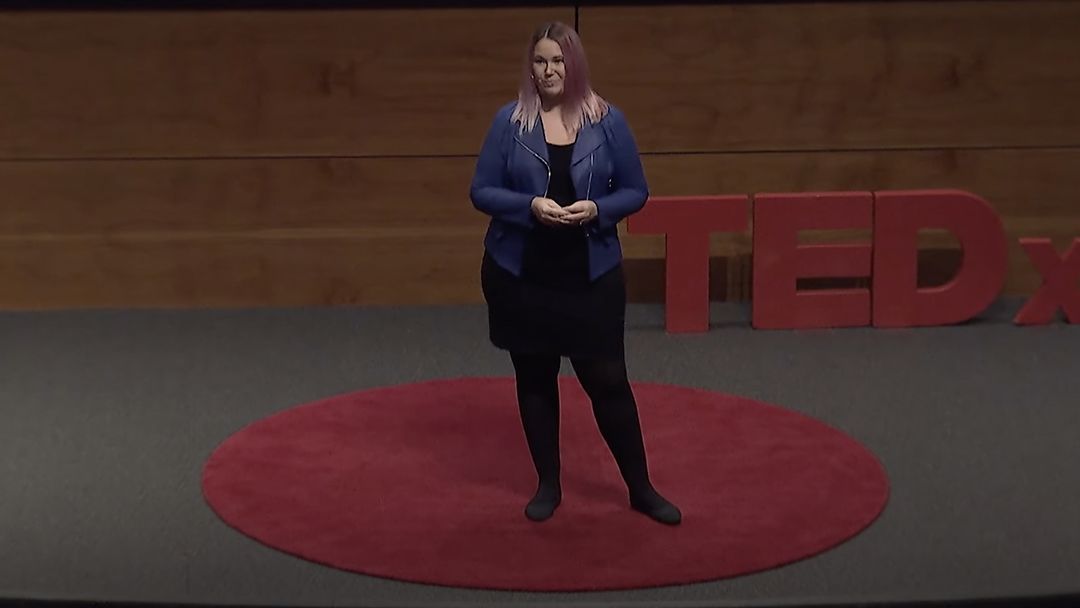
The real-world influence of Star Trek

Something weird is happening in our galaxy

What really killed the dinosaurs? (It wasn’t just the asteroid)
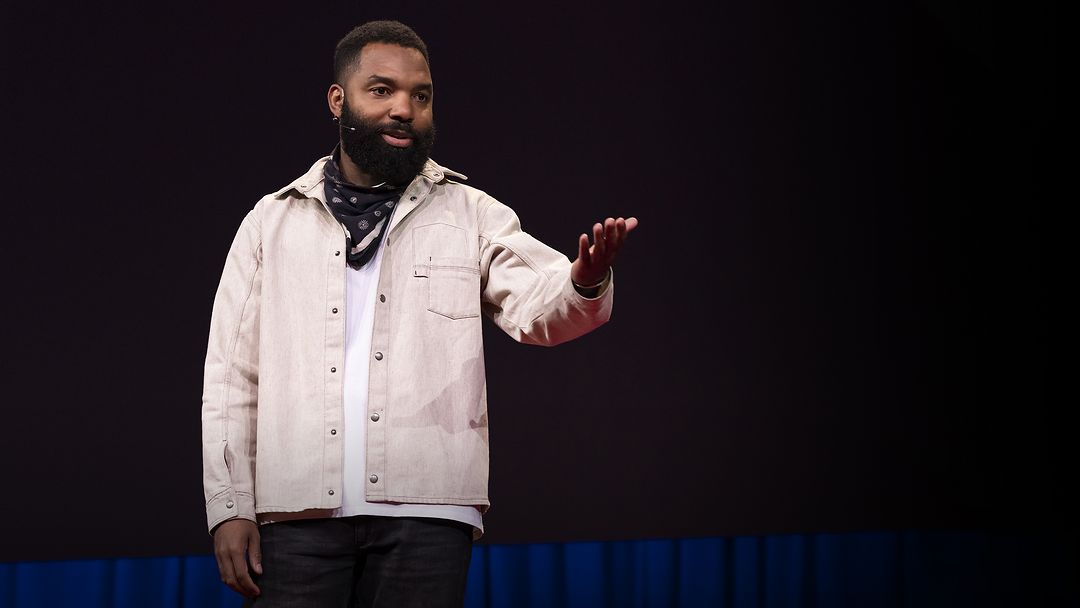
The Encyclopedia of Invisibility — a home for lost stories
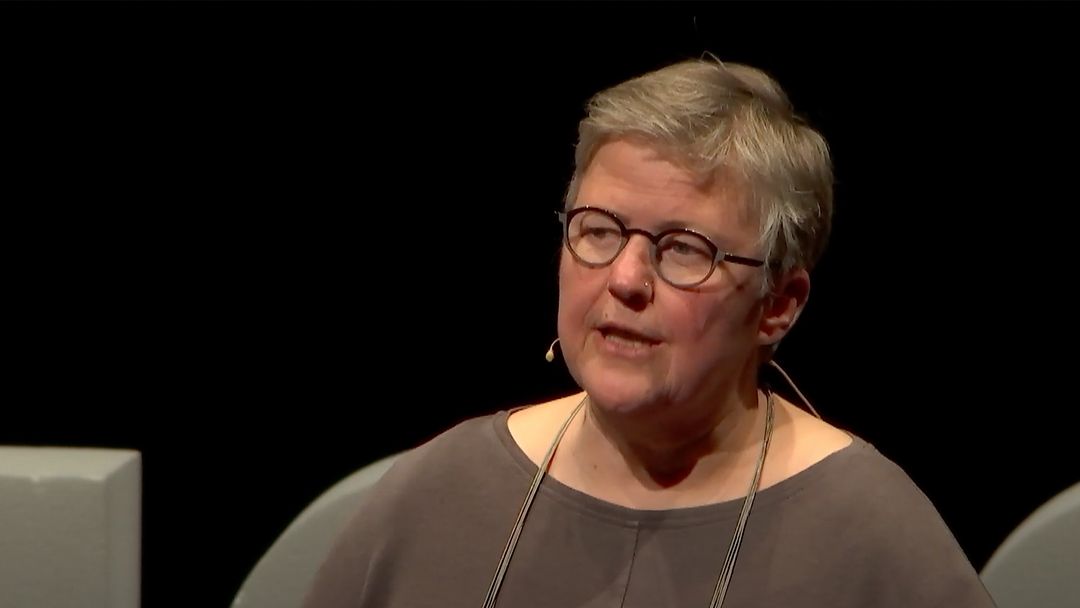
How new drugs could come from space

Whoever builds something here will be rich beyond measure

The battle that formed the universe
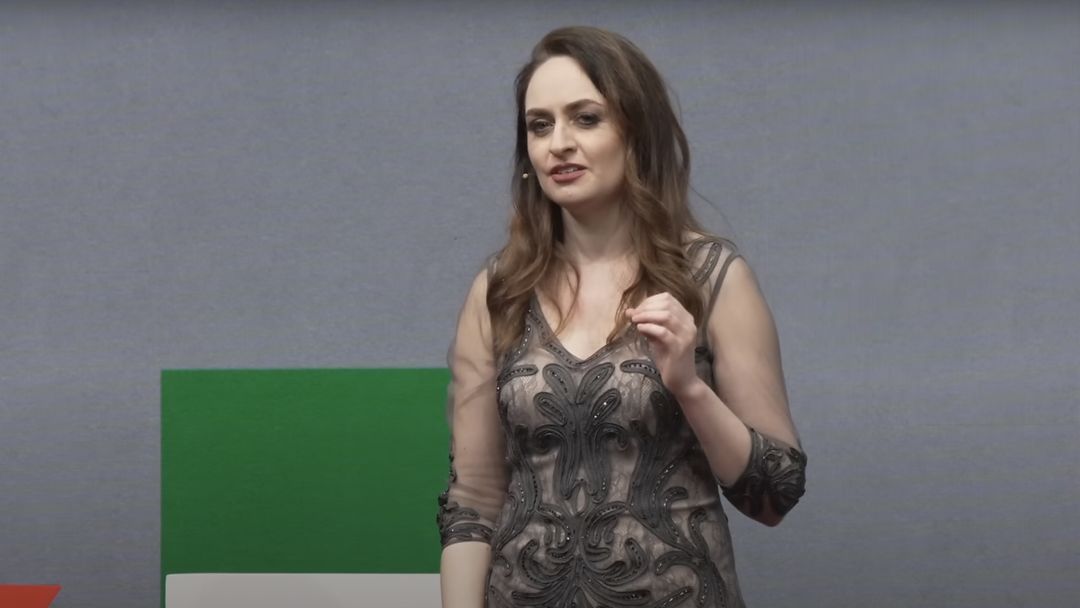
Why we should search for alien artifacts

The outlaws of the ocean — and how we're reeling them in
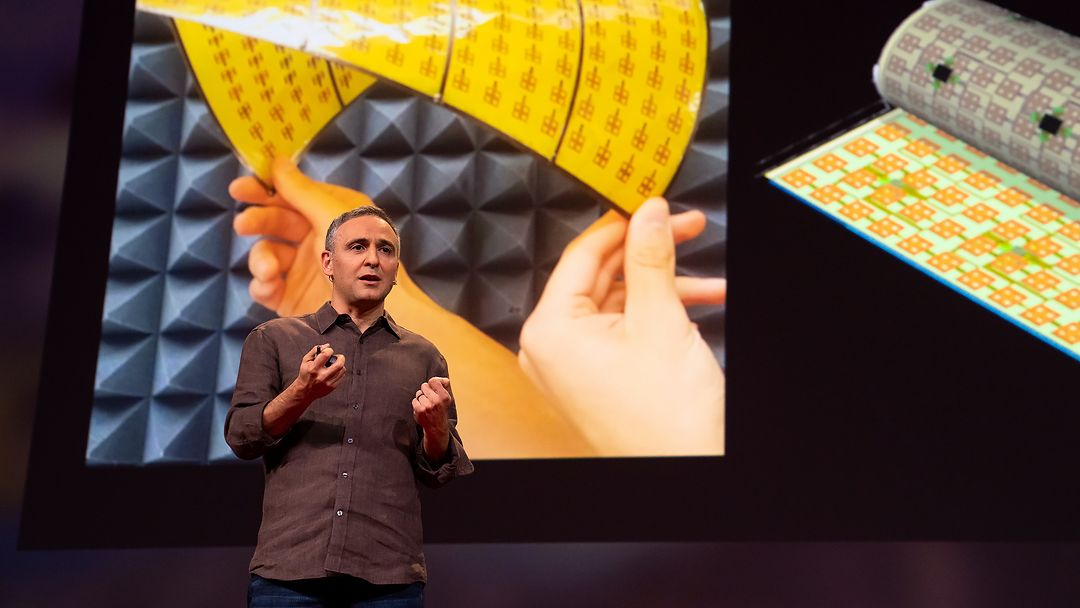
How wireless energy from space could power everything
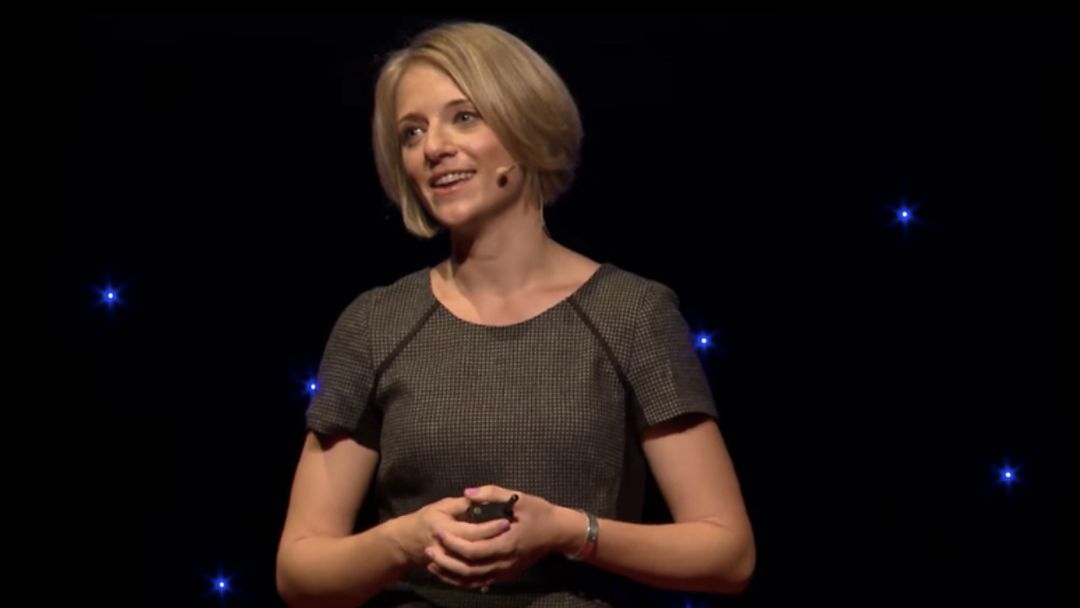
The history (and future) of women in STEM

Gourmet food for the final frontier

What the discovery of exoplanets reveals about the universe
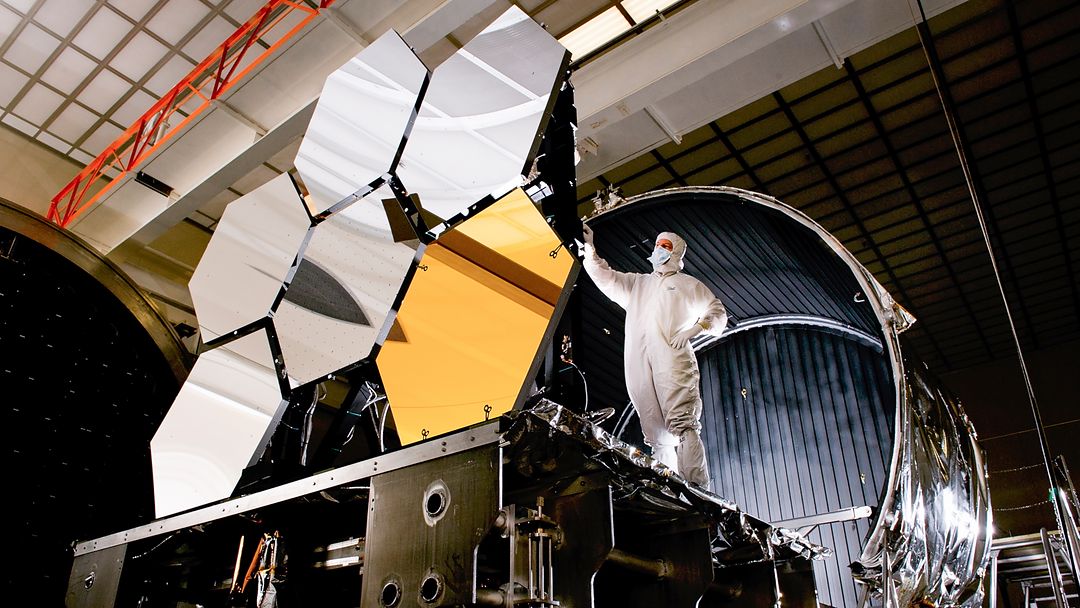
The marvels and mysteries revealed by the James Webb Space Telescope
Exclusive articles about space, the jaw-droppingly high, out-of-this-world carbon footprint of space tourism, a bold step for womankind: meet the young women behind kyrgyzstan’s satellite program, a delightful art project for anyone who’s ever dreamed of living on the moon.

This Week in Space History: Famous Space Speeches
Sep 10, 2022 | Crewed Space , Daily Space , NASA , Space History , Space Policy

One of the things we realized last season is that we focused too much on satellites and launches in the history segment and ended up talking about eleventy billion slightly different space shuttle missions. There’s a lot more space history to cover. This week’s segment of This Week in Space History will be about significant presidential space policy speeches, and future segments will feature important people and significant events.
An example of “significant space policy speeches” is President Kennedy’s “we choose to go to the Moon” speech, which happened this coming week in 1962.
On September 12, 1962, at Rice University near Houston, Texas, President Kennedy informed the public at large that the United States was finally going to win the Space Race by putting a man on the Moon. This was right at the highest point of the Cold War when the U.S. and the Soviet Union were aiming nuclear weapons at each other and waiting for the other side to blink in the Cuban Missile Crisis. The Space Race was a less violent way for the two nations to compete, though the origins of satellite launch began with the very same missiles, just lacking nuclear warheads.
Both the United States and the Soviet Union came up with novel ways to one-up each other: first to orbit, first to fly by another planet, etc. The ultimate goal, at least from the U.S.’s perspective, was to land a human on the Moon and return him to Earth. (As a reminder, the first American woman wouldn’t go to space until 1983.) Up until that point, the Soviets had been the first to hit most major milestones. President Kennedy’s ambitious goal gave Americans something positive to look forward to, instead of the potentially apocalyptic conflict.

While the most important topic of President Kennedy’s speech was the lunar program announcement, he also had to win over the American people. Much of the framing of the speech talks about humanity’s history of exploration and science, and how America specifically contributed to it. He also addressed criticism of the proposal, since you couldn’t get away from people complaining about the cost of the space program and how it would benefit them even when it was a pure Cold War propaganda machine.
The quote “we choose to go to the moon and do the other things not because they are easy but because they are hard…” is what the speech is best remembered for. After Kennedy was assassinated a year later, the program was given new importance and successfully completed just in time for his deadline with the landing of Apollo 11 on July 20, 1969.
Kennedy wasn’t the only president to make space policy a major part of his administration. Several others did as well and announced their programs with speeches, such as George H. W. Bush on July 20, 1989.
President Bush Sr. presented his Space Exploration Initiative to the nation, a program where NASA would build a space station in Earth orbit, send humans back to the Moon in a more permanent fashion, and from there go on to Mars. Sound like Artemis? Sadly, nearly the entire program was canceled in 1993 because of cost. The space station, originally called Freedom, only survived because of its incorporation into the ISS program with Russia and others after the fall of the Soviet Union in 1991.

The next major presidential space policy speech was given by President George W. Bush (Bush 43) on January 14, 2004. President Bush Jr announced the Vision for Space Exploration. The Constellation program, NASA’s implementation of this policy, planned to return humans to the Moon as a stepping stone to Mars, using shuttle-derived rockets called Ares I and V.
Constellation was canceled in 2009 by Barack Obama but not really. The same contracts and everything were kept, turning what the design had morphed into at the very end of the Constellation program into the modern Space Launch System . That rocket, after a long development program, is currently sitting on the pad at 39B under a different name, Artemis .
Perhaps the most significant space policy speech was given by a Vice President, not the sitting president. On March 26, 2019, during a meeting of the National Space Council, Vice President Pence formally announced the Artemis program with the goal of putting the “first woman and next man” on the Moon in 2024 — much earlier than the previous goal of 2028. The Artemis program would use the existing SLS rocket and Orion spacecraft first conceived of in the Constellation program. The difference between this attempt and all the others that came before was designed sustainability. Artemis would have a space station in orbit of the Moon to allow repeated landings and longer stays in lunar orbit. Artemis also involves commercial companies in several aspects, from cargo resupply of the space station to the crewed lander itself.
More Information
Address at Rice Univesity on the Nation’s Space Effort (JFK Presidential Library and Museum)
US to Return Astronauts to the Moon by 2024 , VP Pence Says ( Space.com )
Got Podcast?

URL * RSS * iTunes

URL * RSS * iTunes * YouTube

SUBSCRIBE TO STAY CONNECTED!
Speech Room News
Speech & Language Therapy Resources
How to Teach Spatial Concepts Using 7 Hands-On Activities
11/24/2020 by Jenna Leave a Comment
Don’t spend all of your therapy time quizzing kids on concepts. Make sure you take the time to teach them the skills that they need first in order to understand these concepts. Do your students struggle with learning positional or spatial words and concepts such as: on, beside, next to, on top of? Students who have difficulties with language skills sometimes especially have a hard time with understanding spatial words. Students LOVE hands-on activities and they are proven to keep them much more engaged than a worksheet! Below are some ideas for teaching spatial concepts as well as ways to practice including 7 hands-on activities for teaching spatial concepts in speech therapy.
Some important things you should do when first teaching about spatial concepts in speech therapy:
- Use a stuffed animal
Children love to play at any time of the day, so when school and therapy feel like play, you are bound to get more out of them with their learning. You can use a stuffed animal to give them directions on what to do with the stuffed animal such as, “Put the animal on top of the cabinet” or “Put the animal on the bottom shelf .”
- Teach in opposites
Teaching opposite words can make spatial concepts easier for students to understand. For example- teach the words “on” and “off” at the same time or “up” and “down” and use contrast to further explain.
- Create a visual cue
Visual cues help students understand things so much easier (like a picture of a box with something in and something out.) It is important to keep your visuals consistent with each spatial concept that you teach so that your students do not become confused.
- Focus on one set at a time until mastery
Rather than trying to teach your students 10 different spatial concepts in one speech therapy session, focus on one concept for the week and make sure that they really understand it and have mastered the understanding of that spatial concept before moving on to teach them a new one.
- Use a multi-sensory approach
If teaching about the spatial concepts: top, middle, bottom, then have the student touch their head and SAY top, touch their stomach and SAY middle and then touch their feet and SAY bottom. This kinesthetic approach will help make these concepts “stick” in their brain.
After you have used the guidelines above to start the teaching portion of these spatial concepts, then you can really start to have fun with your students by playing and doing some more hands-on activities about spatial concepts in speech therapy that they will love!

Here are 7 hands-on activities for teaching spatial concepts in speech therapy:
- Following directions games (with seasonal objects)
Since it is fall right now, you could use leaves, apples and pumpkins as your seasonal objects. (Change these to fit the season that you are in.) Have your students put the objects in different places around your room. For example- You can tell them to, ”Put the pumpkin under the table” or “Put the apple next to the shelf.”
- Build with Plastic Bricks
Building with plastic bricks is always fun (and great for their fine motor skills also- which is a win win!) You can very easily work on the skill of spatial concepts in speech therapy while building with legos and your students probably will not even realize that they are learning because they will be having so much fun! As you are building, use language such as, “ Can you put this red brick on top of that blue brick?” After you work on spatial concepts during the building phase, then you can even add in other figurines and practice these spatial concept skills again. An example would be to use an elf at Christmas time and say “Can you put the elf on top of the sleigh that you built?” You can see all my plastic brick materials here .
- Build gingerbread houses
The holidays are quickly approaching! You can make teaching spatial concepts really fun and engaging during this time of the year by using this Gingerbread Concepts Activity . This activity helps target following directions and positional/spatial concepts while building a gingerbread house.

- Use books and the pictures
The book, “The Mitten” is a classic for teaching spatial concepts to students especially during the winter season. On each page of the story, a different animal crawls in the mitten to stay warm. You can make book companion cards to go with the story or use these for preschool speech and language. Another great book to read with young students is “If You Take a Mouse to School.” There is another book companion bundle for this story that you can check out here that has a spatial/ positional words activity to go with it.
- Use barrier games
Barrier games can be played with commercial barrier game materials such as MangeTalk Match-Ups from Super Duper Publications or using file folders that you create on your own. Barrier games are used to target a variety of speech and language skills including: following directions, deductive reasoning, giving directions, vocabulary, sentence formation, auditory memory, storytelling, basic concepts, categorization. This Winter Barrier Game is great for working on spatial concepts with young students such as preschoolers.
- Make books for repeated practice
Did you know that kids typically need to see something 8 times before they remember it? Repeated practice is always necessary with younger students, especially students that might have any speech and language delays. Making a book for repeated practice such as this Interactive Vocabulary Book: Kitty Positional Concepts or Interactive Vocabulary Books: Puppy Prepositions are really great ways for students to practice the skill of identifying spatial/ positional concepts many times during speech therapy. These Interactive Vocabulary Books can actually be printed and used with velcro or be used with Boom cards in a digital format. These books are especially great for minimally verbal students. They can show their knowledge without needing to verbally produce answers, just match. For kids just learning to express themselves in single words or simple phrases, pictures support that level of speech.
- Use Play dough
Learning should always be fun, right?! Try letting students use play-doh to successfully work on spatial concepts. This Dough and Data Set is one way you can do it. Tell the student to place the red play-doh on the apple or put the green play-doh apple between the red and yellow apples. Play-doh is a great way to keep students engaged, keep their hands busy and keep learning fun!
Teaching about spatial concepts in speech therapy does not have to be boring! Your students can absolutely have fun while they are learning and better yet-be participating in hands-on and engaging activities!
How do you teach about positional or spatial words during therapy?

Join the SRN newsletter!

I'm so glad you stopped by! If you'd like to keep up with the newest posts and get exclusive free downloads, please sign up for the newsletter! Your first freebie is ready as soon as you subscribe and confirm your email!
Success! Now check your email to confirm your subscription.
There was an error submitting your subscription. Please try again.
Leave a Reply Cancel reply
Your email address will not be published. Required fields are marked *
This site uses Akismet to reduce spam. Learn how your comment data is processed .
Keep up with the newest posts and get exclusive free downloads!
111th Commencement of Rice University - May 3-4 - Watch All Ceremonies
“We choose to go to the Moon”
"We choose to go to the Moon", officially titled the address at Rice University on the nation's space effort, is a September 12, 1962, speech by United States President John F. Kennedy to further inform the public about his plan to land a man on the Moon before 1970.
President Pitzer, Mr. Vice President, Governor, Congressman Thomas, Senator Wiley, and Congressman Miller, Mr. Webb, Mr. Bell, scientists, distinguished guests, and ladies and gentlemen:
I appreciate your president having made me an honorary visiting professor, and I will assure you that my first lecture will be very brief.
I am delighted to be here, and I’m particularly delighted to be here on this occasion.
We meet at a college noted for knowledge, in a city noted for progress, in a state noted for strength, and we stand in need of all three, for we meet in an hour of change and challenge, in a decade of hope and fear, in an age of both knowledge and ignorance. The greater our knowledge increases, the greater our ignorance unfolds.
Despite the striking fact that most of the scientists that the world has ever known are alive and working today, despite the fact that this nation’s own scientific manpower is doubling every 12 years in a rate of growth more than three times that of our population as a whole, despite that, the vast stretches of the unknown and the unanswered and the unfinished still far outstrip our collective comprehension.
No man can fully grasp how far and how fast we have come, but condense, if you will, the 50,000 years of man’s recorded history in a time span of but a half-century. Stated in these terms, we know very little about the first 40 years, except at the end of them advanced man had learned to use the skins of animals to cover them. Then about 10 years ago, under this standard, man emerged from his caves to construct other kinds of shelter. Only five years ago man learned to write and use a cart with wheels. Christianity began less than two years ago. The printing press came this year, and then less than two months ago, during this whole 50-year span of human history, the steam engine provided a new source of power.
Newton explored the meaning of gravity. Last month electric lights and telephones and automobiles and airplanes became available. Only last week did we develop penicillin and television and nuclear power, and now if America’s new spacecraft succeeds in reaching Venus, we will have literally reached the stars before midnight tonight.
This is a breathtaking pace, and such a pace cannot help but create new ills as it dispels old, new ignorance, new problems, new dangers. Surely the opening vistas of space promise high costs and hardships, as well as high reward.
So it is not surprising that some would have us stay where we are a little longer to rest, to wait. But this city of Houston, this State of Texas, this country of the United States was not built by those who waited and rested and wished to look behind them. This country was conquered by those who moved forward — and so will space.
William Bradford, speaking in 1630 of the founding of the Plymouth Bay Colony, said that all great and honorable actions are accompanied with great difficulties, and both must be enterprised and overcome with answerable courage.
If this capsule history of our progress teaches us anything, it is that man, in his quest for knowledge and progress, is determined and cannot be deterred. The exploration of space will go ahead, whether we join in it or not, and it is one of the great adventures of all time, and no nation which expects to be the leader of other nations can expect to stay behind in the race for space.
Those who came before us made certain that this country rode the first waves of the industrial revolutions, the first waves of modern invention, and the first wave of nuclear power, and this generation does not intend to founder in the backwash of the coming age of space. We mean to be a part of it — we mean to lead it. For the eyes of the world now look into space, to the moon and to the planets beyond, and we have vowed that we shall not see it governed by a hostile flag of conquest, but by a banner of freedom and peace. We have vowed that we shall not see space filled with weapons of mass destruction, but with instruments of knowledge and understanding.
Yet the vows of this nation can only be fulfilled if we in this nation are first, and, therefore, we intend to be first. In short, our leadership in science and in industry, our hopes for peace and security, our obligations to ourselves as well as others, all require us to make this effort, to solve these mysteries, to solve them for the good of all men, and to become the world’s leading space-faring nation.
We set sail on this new sea because there is new knowledge to be gained, and new rights to be won, and they must be won and used for the progress of all people. For space science, like nuclear science and all technology, has no conscience of its own. Whether it will become a force for good or ill depends on man, and only if the United States occupies a position of pre-eminence can we help decide whether this new ocean will be a sea of peace or a new terrifying theater of war. I do not say the we should or will go unprotected against the hostile misuse of space any more than we go unprotected against the hostile use of land or sea, but I do say that space can be explored and mastered without feeding the fires of war, without repeating the mistakes that man has made in extending his writ around this globe of ours.
There is no strife, no prejudice, no national conflict in outer space as yet. Its hazards are hostile to us all. Its conquest deserves the best of all mankind, and its opportunity for peaceful cooperation may never come again. But why, some say, the moon? Why choose this as our goal? And they may well ask why climb the highest mountain? Why, 35 years ago, fly the Atlantic? Why does Rice play Texas?
We choose to go to the moon. We choose to go to the moon in this decade and do the other things, not because they are easy, but because they are hard, because that goal will serve to organize and measure the best of our energies and skills, because that challenge is one that we are willing to accept, one we are unwilling to postpone, and one which we intend to win, and the others, too.
It is for these reasons that I regard the decision last year to shift our efforts in space from low to high gear as among the most important decisions that will be made during my incumbency in the office of the presidency.
In the last 24 hours, we have seen facilities now being created for the greatest and most complex exploration in man’s history. We have felt the ground shake and the air shattered by the testing of a Saturn C-1 booster rocket, many times as powerful as the Atlas which launched John Glenn, generating power equivalent to 10,000 automobiles with their accelerators on the floor. We have seen the site where five F-1 rocket engines, each one as powerful as all eight engines of the Saturn combined, will be clustered together to make the advanced Saturn missile, assembled in a new building to be built at Cape Canaveral as tall as a 48-story structure, as wide as a city block, and as long as two lengths of this field.
Within these last 19 months at least 45 satellites have circled the earth. Some 40 of them were “made in the United States of America,” and they were far more sophisticated and supplied far more knowledge to the people of the world than those of the Soviet Union.
The Mariner spacecraft now on its way to Venus is the most intricate instrument in the history of space science. The accuracy of that shot is comparable to firing a missile from Cape Canaveral and dropping it in this stadium between the 40-yard lines.
Transit satellites are helping our ships at sea to steer a safer course. Tiros satellites have given us unprecedented warnings of hurricanes and storms, and will do the same for forest fires and icebergs.
We have had our failures, but so have others, even if they do not admit them. And they may be less public.
To be sure, we are behind, and will be behind for some time in manned flight. But we do not intend to stay behind, and in this decade, we shall make up and move ahead.
The growth of our science and education will be enriched by new knowledge of our universe and environment, by new techniques of learning and mapping and observation, by new tools and computers for industry, medicine, the home as well as the school. Technical institutions, such as Rice, will reap the harvest of these gains.
And finally, the space effort itself, while still in its infancy, has already created a great number of new companies, and tens of thousands of new jobs. Space and related industries are generating new demands in investment and skilled personnel, and this city and this state, and this region, will share greatly in this growth. What was once the furthest outpost on the old frontier of the West will be the furthest outpost on the new frontier of science and space. Houston, your city of Houston, with its Manned Spacecraft Center, will become the heart of a large scientific and engineering community. During the next five years the National Aeronautics and Space Administration expects to double the number of scientists and engineers in this area, to increase its outlays for salaries and expenses to $60 million a year; to invest some $200 million in plant and laboratory facilities; and to direct or contract for new space efforts over $1 billion from this center in this city.
To be sure, all of this costs us all a good deal of money. This year’s space budget is three times what it was in January 1961, and it is greater than the space budget of the previous eight years combined. That budget now stands at $5,400,000 a year — a staggering sum, though somewhat less than we pay for cigarettes and cigars every year. Space expenditures will soon rise some more, from 40 cents per person per week to more than 50 cents a week for every man, woman and child in the United States, for we have given this program a high national priority — even though I realize that this is in some measure an act of faith and vision, for we do not now know what benefits await us.
But if I were to say, my fellow citizens, that we shall send to the moon, 240,000 miles away from the control station in Houston, a giant rocket more than 300 feet tall, the length of this football field, made of new metal alloys, some of which have not yet been invented, capable of standing heat and stresses several times more than have ever been experienced, fitted together with a precision better than the finest watch, carrying all the equipment needed for propulsion, guidance, control, communications, food and survival, on an untried mission, to an unknown celestial body, and then return it safely to Earth, re-entering the atmosphere at speeds of over 25,000 miles per hour, causing heat about half that of the temperature of the sun — almost as hot as it is here today — and do all this, and do it right, and do it first before this decade is out — then we must be bold.
I’m the one who is doing all the work, so we just want you to stay cool for a minute. [laughter]
However, I think we’re going to do it, and I think that we must pay what needs to be paid. I don’t think we ought to waste any money, but I think we ought to do the job. And this will be done in the decade of the sixties. It may be done while some of you are still here at school at this college and university. It will be done during the term of office of some of the people who sit here on this platform. But it will be done. And it will be done before the end of this decade.
I am delighted that this university is playing a part in putting a man on the moon as part of a great national effort of the United States of America.
Many years ago, the great British explorer George Mallory, who was to die on Mount Everest, was asked why did he want to climb it? He said, “Because it is there.”
Well, space is there, and we’re going to climb it, and the moon and the planets are there, and new hopes for knowledge and peace are there. And, therefore, as we set sail we ask God’s blessing on the most hazardous and dangerous and greatest adventure on which man has ever embarked.

2 Minute Speech On Space In English
Good morning to everyone in this room. I would like to thank the principal, the teachers, and my dear friends for allowing me to speak to you today about space. Space is a continuous, empty area or expanse that is available, free, and limitless. It is an infinite three-dimensional space where things move and behave in relation to one another.
It is the area above and surrounding our planet where neither air nor light can be spread. It is a void that is empty of any material in which sound cannot travel. Only when the earth is viewed from space does it appear circular. Just land and sea are visible. Because there is no gravity in space, objects float in the air.
The first satellite, known as Sputnik, was launched into space by the former Soviet Union in 1957, marking the beginning of space travel. The launch of several satellites and probes into orbit. This is done to keep an eye on the planet, gather information about the temperature and weather, support contemporary navigation systems, study distant celestial bodies, and conduct space-related scientific research. On April 12, 1961, Yuri Gagarin became the first person to enter space.
While operating in space, Sunita Williams, an astronaut, achieved a number of firsts. She is most recognized for her spacewalks and work on the International Space Station. She broke the previous record for the longest space journey by a woman and gave thousands of kids and students a glimpse of life in orbit. She praised the view of the planet as breathtaking and claimed she could sit at the spacecraft’s window and gaze at it for hours. Thank you.
Related Posts:
- A Grammarian's Funeral by Robert Browning Summary
- Random Occupation Generator
- Michael Poem by William Wordsworth Summary, Notes and Line by Line Explanation in English
- Of Travel Summary by Francis Bacon
- Random Ability Generator Pokemon
- Howl Poem By Allen Ginsberg Summary, Notes and Line by Line Explanation in English

(713) 252-2082
- Teletherapy

Myofunctional, Feeding, and Speech Therapy centrally located in Houston

Our Mission
Our mission is to provide the highest-quality speech therapy in a playful environment that encourages confidence and learning. We believe that early intervention and parental involvement are key components to maximizing our patients' long-term success.
Site Content
Our team is comprised only of Masters-level speech-language pathologists. Our therapists have completed extensive training in a variety of areas in order to provide the most specialized care. possible. We treat a wide range of etiologies and diagnoses that affect communication.
Our therapists have certifications or extensive training in the following programs: Feeding, Picky Eating Habits, Orofacial Myology/Myofunctional Therapy, Tethered Oral Tissues (Tongue/Lip ties) Apraxia, Phonological Disorders, and Speech Articulation Disorders.
Custom Care
We proudly offer many options for families, matching our patients with the speech therapist most suited to their individual needs. We believe in tailoring therapy frequency and duration to each patient's needs. And we have the capability of offering teletherapy sessions when in-person therapy is not possible.
The Speech Space
2990 Richmond Ave (Suite 203), Houston, TX 77098
Copyright © 2024 The Speech Space - All Rights Reserved.
Powered by GoDaddy Website Builder
This website uses cookies.
We use cookies to analyze website traffic and optimize your website experience. By accepting our use of cookies, your data will be aggregated with all other user data.

Presentation Skill: The Benefits of Using Physical Space
June 12, 2015 / Blog audience engagement, presentation space, presentation tips, Rick Enrico, SlideGenius, using physical space
You may have prepared an interactive PowerPoint presentation or may have crafted a powerful pitch, but there’s one important thing you might’ve overlooked: the importance of maximizing your space while you perform.
Whether you’re giving your business proposal in a boardroom or in a large hall, the goal is always to attract the audience’s attention and retain it until the end.

We redesign PowerPoint presentations.
Get your free quote now..
Moving and staying closer to your audience makes them feel that you want to personally connect with them.
While some public speakers hide behind a lectern, there are professionals who maximize their stage presence to fully engage their audience .
The Importance of Space
One of the subcategories of nonverbal communication is called “proxemics,” a term developed by American anthropologist Edward T. Hall.
This is the study of the effects of using physical space and distance between individuals. It’s how a certain person perceives intimacy when interacting with somebody else.
When it comes to public speaking, how your audience understands your message depends on how you move around your stage or move closer to your audience.
According to Hall, there are four main zones of physical space: intimate (a foot and a half to zero), personal (four feet to a foot and a half), social (twelve feet to four feet), and public (twelve feet or more).
Just as eye contact , gestures, and body language achieve effective communication, physical space contributes to a more successful pitch.
How It Benefits the Speaker
For presenters, interacting with the audience using these zones of physical space may vary depending on how wide the conference room or stage is.
For speech trainer Olivia Mitchell, you can interact and maximize your space in a number of ways, including planning out your position on the stage, using a stage timeline, or moving along with the flow of your speech.
Understanding the benefits of using stage space helps you build an effective relationship with your audience.
It Adds Impact
Apart from your content’s message, tone of voice, facial expressions and body movements, the significance of physical space influences how your audience perceives you as a presenter.
When you enthusiastically discuss, it shows that you’re passionate about your topic and wish to share this amazing information with your audience.
It Promotes Trust
Can you imagine talking to a close friend or colleague without being physically close? How about being up-close and personal with a stranger?
Distance also affects how you connect to your audience. According to Six Minutes’ Andrew Dlugan, bridging the physical gap between you and your listeners further connects you to them .
If the venue hinders you from moving closer to the crowd, you can still connect with them by maximizing your body movements and maintaining eye contact.
It Makes You Look Confident
While political leaders use lecterns to look more authoritative, some professional presenters prefer moving around the podium.
Presenters who stand still in one spot appear unconfident and unprepared. Nervous presenters hide behind lecterns and rely on their notes.
Knowing that you’ve prepared well for your pitch makes you want to move closer to your audience to communicate naturally and confidently.
Understanding how physical space benefits your presentation helps you build an effective relationship with your audience.
A speaker who knows how to move around the stage appears more confident than one who simply stays put.
Always be aware of the four main zones of physical space. Know when to use the intimate, personal, social, and public distances. For instance, you can’t be intimate at the beginning of your pitch because you are a stranger to your audience.
Meanwhile, maintaining a public distance a good thirty minutes into your speech indicates that you don’t trust your audience.
To craft an effective PowerPoint presentation, let SlideGenius experts help you out!

Download free PowerPoint templates now.
Get professionally designed PowerPoint slides weekly.
“ 9 Ways to Use Space in Your Presentation .” Speaking about Presenting . Accessed June 12, 2015. “ How to Connect With Your Audience by Moving Closer .” Six Minutes . Accessed June 12, 2015. “ Presentation Tips: 5 Quick Steps to Audience Engagement .” SlideGenius, Inc . December 16, 2014. Accessed “ How to Maximize Eye Contact for Presentations .” SlideGenius, Inc . 2015. Accessed June 12, 2015. “ Proxemics .” Communication Studies . Accessed July 9, 2018.
Popular Posts
Save your deck: methods to recover an unsaved powerpoint file.

Twitter: Lessons from Social Media

Oscar Speech Sounds A Lot Like…..

Olympians Can Teach Presenters a Thing or Two

Overcoming a Public Speaking Disaster: A Lesson from Michael Bay

The Similarities Between Presentations and Advertisments : Super Bowl Edition

Welcome to The Speech Space!
(202) 643.8250 [email protected] 2141 Wisconsin Ave. NW, Unit M, Washington DC 20007
The Speech Space is a pediatric speech therapy and occupational therapy practice that provides individually tailored services to the early childhood population. Our office location in Glover Park is specifically designed for the children we work with and was recently renovated. The office is filled with a vast variety of toys and games which have been specially curated over our combined 20+ years of experience to motivate, engage and grow your child’s skills. Our sensory gym has been thoughtfully designed for children with sensory, self regulation, attention, fine motor, and motor planning needs.
We focus on helping your child explore their potential through play-based therapy in a fun and supportive environment. We believe children learn best when they are engaged and excited. Through a balance of child and adult directed activities, we seek to maximize a your child’s experience and growth in each session. Additionally, we recognize each child is unique and we are flexible in designing our sessions and treatment plans specifically for each individual child!
Each of our wonderful speech therapists specialize in working with children exhibiting: receptive language delays, expressive language delays, mixed expressive-receptive language delays, language processing difficulties, articulation delays, oral motor weakness, motor planning issues, feeding difficulties, disfluencies, and social skill weaknesses.
Our fantastic occupational therapist specializes in early intervention, sensory integration therapy, primitive reflex integration therapy, sensory-based feeding therapy, fine motor skills, aquatic therapy, social skills, and handwriting.
It Takes a Village!
We are so lucky to work closely with other pediatric specialists and schools in the area.

Speech Therapy Bulletin Boards- Functional ways to use space in your speech room
Feb 13, 2016 | 8 comments

Who said bulletin boards were just for classroom teachers? Speech therapy bulletin boards can add function and color to your room! Back when I first started my career, making my room “cute” and “color coordinated” wasn’t really my thang. I often had office rooms that shared with psychologists or RSP teachers or I was stuck in a small box in the cafeteria that didn’t really scream “decorate” me! Not to mention that one year, I covered lots of charters, so I was driving around a lot delivering services in the cafeteria, storage closets, the library…shall I go on?

Now, I love using speech therapy bulletin boards in my rooms. I work at sites that have a room JUST.FOR.ME. and they have great wall space. They aren’t the biggest rooms in town, but it’s all mine with storage space (this girl knows she has it good).
How To Stay Inspired & Get Ideas For Speech Therapy Bulletin Boards
Pinterest is a great way to get ideas for your next speech therapy bulletin board. If you need functional speech therapy bulletin board ideas, come follow speech therapy bulletin boards and decor pinterest board . You can also join speech pathology facebook groups and ask for suggestions. Or you can search “speech therapy bulletin boards” in the group and see what others may have already posted for ideas.

When I create a bulletin board for my speech room, I try to think of something that can stay up all year long. It has to help me with teaching goals too. If you still don’t know what bulletin boards you might like, then look at your caseload. See what re-occurring goals you are going to be targeting. What visuals could you put up to help with those goals? Or ask yourself, what systems or procedures do you want to stay consistent with during the year? That could be a bulletin board! You could make a visual schedule or rules bulletin board to go over before starting every session. Or have a data or goal bulletin board that students have to look at their goal or progress.

When administrators, teachers or parents walk in, they get to see a glimpse of where the speech students go each week. By using functional speech therapy bulletin boards you are also showing your staff all the amazing areas of speech and language you cover! Here are some tips when you are creating bulletin boards!

Buy a fabric instead of using paper as your background. It won’t fade or rip, so you can use it year after year! Using a double border also helps with making your bulletin board stand out. I used push pins on the bulletin board to hang my Interactive Articulation Flip Books for easy access. I added FREE question posters above my bulletin board for a visual reference that you can download from Primary Punch HERE .
This year, I did not use a specific theme like “summer” or “jungle”, which makes it much easier for shopping for decor!
Social Skill Bulletin Boards To Review Vocabulary & Concepts

Visually Display Wh-Question Words

Vocabulary Bulletin Board Ideas

The Speech Bubble SLP has this very functional speech therapy bulletin board for working on inferencing! I love it because you can keep it up all year and target inferencing as a warm up during each session.

Articulation Bulletin Board Ideas

Do YOU have a fantastic speech therapy bulletin board in your speech room?! Email me a picture at fe*********@th*****************.com , so I can feature your ideas in an upcoming blog post!!
I hope everyone who reads it finds comfort in your words. Overall great article! “The mission of Language Loft Speech and Language Services, Inc. is to help children communicate and express themselves while supplying parents and teachers with the tools to help facilitate carry-over of learned skills into their natural environment.” http://www.thelanguageloft.com/
Great ideas! I’m going with Superheroes this year!
Where can I get the WH question visuals above the describe it bulletin board from!?
Here! They are FREE and awesome! https://www.teacherspayteachers.com/Product/Question-Word-Posters-2046491
Hi there! Love your materials and your creativity! I was wondering, where can I find the “Making Impressions” bulletin board? Also did you create the posters above the whiteboard (the pictures with the earth, the box, the hand,etc.). Thanks and keep up the great work!!
Hey Nanette…here are my bulletin board resources… https://www.teacherspayteachers.com/Store/The-Dabbling-Speechie/Category/Bulletin-Boards-214713 I got the posters in Primary Punch’s store (FREE) https://www.teacherspayteachers.com/Product/Question-Word-Posters-2046491
Please please tell me where u for the cute WH posters I saw on the wall above one of your bulletin board ideas. It was above the “describe it” and “key to communication” board. Can u tell me?
https://www.teacherspayteachers.com/Product/Question-Word-Posters-2046491 Here is the link!
- AAC Communication
- Apps for Therapy
- articulation
- Basic Concepts
- Behavior Management
- Books for Speech Therapy
- Boom Cards Speech Therapy
- Caseload Management
- Clinical Fellowship Year
- Collaborative Services
- Conversation Scripts
- craftivities
- Digital Speech Therapy Materials
- DIY materials
- Featured #1
- Featured #2
- Featured #3
- Featured #4
- Featured #5
- Featured #6
- Games For Speech Therapy
- Middle School Therapy
- organizational tips
- Play-Based Therapy
- Progress Monitoring Speech Goals
- Real Talk SLP
- sensory bins
- SLP Accessories
- social skills
- Speech Assessments
- Speech Life
- Speech Room Decor
- Speech Sound Disorders
- Themed Speech Therapy
- Therapy Materials
- Therapy Plans
- Toys for Speech
- Uncategorized
- Subscriber Freebies
- Shop Products

Kerry Titheradge Is Nervous About Docking in a Tight Space
The windy weather is not helping matters.
Latest Videos

Trending on Bravo

The Real Housewives of New Jersey Season 14 Might Be the Most Dramatic One Yet

Start Watching The Real Housewives of New Jersey Season 14 Premiere Now

Carl Radke Confirms That He and Lindsay Hubbard Were "Holding Back" Information About Their Relationship

The Real Housewives of New Jersey Season 14 Taglines Are Here!

Danielle Cabral Opens Up About Cutting Ties with Her Father
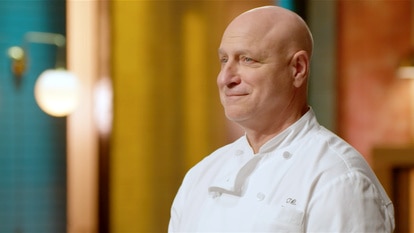
Your Tasty First Look at Last Chance Kitchen Season 21
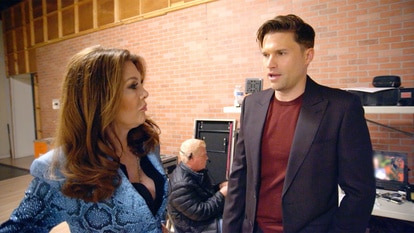
Your First Look at the Vanderpump Rules Season 11 Reunion!

Katie Maloney Reacts to Jo Wenberg's Apology

Where Does Teresa Giudice Stand with the Rest of the Group?

Go Inside Dolores Catania and Paulie Connell's Home

Lala Kent Grills Ariana Madix's New Boyfriend Daniel Wai: "Have You Ever Been Married?"
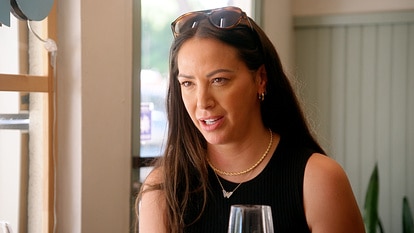
Kristen Doute Spills on Michelle Lally's "Emotional Affair" on Jesse Lally

Mid-Season Finale Part 2
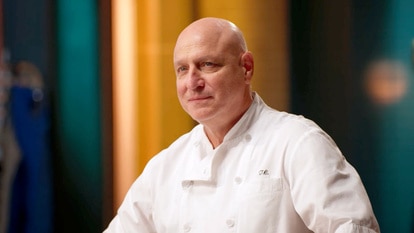
The 16th Chef

Mid-Season Finale Part 1

Dolores Catania Says Rachel Fuda Cropped Teresa Giudice Out in Retaliation
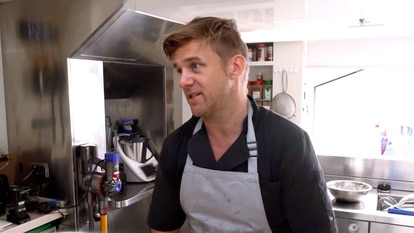
Fraser Olender Is Underwhelmed by Nick Tatlock's Food Presentation

Paige DeSorbo Reveals That Craig Conover Has Never Asked Her When She Wants to Get Engaged
- Share full article
For more audio journalism and storytelling, download New York Times Audio , a new iOS app available for news subscribers.

- May 6, 2024 • 29:23 R.F.K. Jr.’s Battle to Get on the Ballot
- May 3, 2024 • 25:33 The Protesters and the President
- May 2, 2024 • 29:13 Biden Loosens Up on Weed
- May 1, 2024 • 35:16 The New Abortion Fight Before the Supreme Court
- April 30, 2024 • 27:40 The Secret Push That Could Ban TikTok
- April 29, 2024 • 47:53 Trump 2.0: What a Second Trump Presidency Would Bring
- April 26, 2024 • 21:50 Harvey Weinstein Conviction Thrown Out
- April 25, 2024 • 40:33 The Crackdown on Student Protesters
- April 24, 2024 • 32:18 Is $60 Billion Enough to Save Ukraine?
- April 23, 2024 • 30:30 A Salacious Conspiracy or Just 34 Pieces of Paper?
- April 22, 2024 • 24:30 The Evolving Danger of the New Bird Flu
- April 19, 2024 • 30:42 The Supreme Court Takes Up Homelessness
The Protesters and the President
Over the past week, thousands of students protesting the war in gaza have been arrested..
Hosted by Michael Barbaro
Featuring Jonathan Wolfe and Peter Baker
Produced by Diana Nguyen , Luke Vander Ploeg , Alexandra Leigh Young , Nina Feldman and Carlos Prieto
Edited by Lisa Chow and Michael Benoist
Original music by Dan Powell and Marion Lozano
Engineered by Chris Wood
Listen and follow The Daily Apple Podcasts | Spotify | Amazon Music | YouTube
Warning: this episode contains strong language.
Over the past week, students at dozens of universities held demonstrations, set up encampments and, at times, seized academic buildings. In response, administrators at many of those colleges decided to crack down and called in the local police to detain and arrest demonstrators.
As of Thursday, the police had arrested 2,000 people across more than 40 campuses, a situation so startling that President Biden could no longer ignore it.
Jonathan Wolfe, who has been covering the student protests for The Times, and Peter Baker, the chief White House correspondent, discuss the history-making week.
On today’s episode

Jonathan Wolfe , a senior staff editor on the newsletters team at The New York Times.

Peter Baker , the chief White House correspondent for The New York Times covering President Biden and his administration.

Background reading
As crews cleared the remnants of an encampment at U.C.L.A., students and faculty members wondered how the university could have handled protests over the war in Gaza so badly .
Biden denounced violence on campus , breaking his silence after a rash of arrests.
There are a lot of ways to listen to The Daily. Here’s how.
We aim to make transcripts available the next workday after an episode’s publication. You can find them at the top of the page.
The Daily is made by Rachel Quester, Lynsea Garrison, Clare Toeniskoetter, Paige Cowett, Michael Simon Johnson, Brad Fisher, Chris Wood, Jessica Cheung, Stella Tan, Alexandra Leigh Young, Lisa Chow, Eric Krupke, Marc Georges, Luke Vander Ploeg, M.J. Davis Lin, Dan Powell, Sydney Harper, Mike Benoist, Liz O. Baylen, Asthaa Chaturvedi, Rachelle Bonja, Diana Nguyen, Marion Lozano, Corey Schreppel, Rob Szypko, Elisheba Ittoop, Mooj Zadie, Patricia Willens, Rowan Niemisto, Jody Becker, Rikki Novetsky, John Ketchum, Nina Feldman, Will Reid, Carlos Prieto, Ben Calhoun, Susan Lee, Lexie Diao, Mary Wilson, Alex Stern, Dan Farrell, Sophia Lanman, Shannon Lin, Diane Wong, Devon Taylor, Alyssa Moxley, Summer Thomad, Olivia Natt, Daniel Ramirez and Brendan Klinkenberg.
Our theme music is by Jim Brunberg and Ben Landsverk of Wonderly. Special thanks to Sam Dolnick, Paula Szuchman, Lisa Tobin, Larissa Anderson, Julia Simon, Sofia Milan, Mahima Chablani, Elizabeth Davis-Moorer, Jeffrey Miranda, Renan Borelli, Maddy Masiello, Isabella Anderson and Nina Lassam.
Jonathan Wolfe is a senior staff editor on the newsletters team at The Times. More about Jonathan Wolfe
Peter Baker is the chief White House correspondent for The Times. He has covered the last five presidents and sometimes writes analytical pieces that place presidents and their administrations in a larger context and historical framework. More about Peter Baker
Luke Vander Ploeg is a senior producer on “The Daily” and a reporter for the National Desk covering the Midwest. More about Luke Vander Ploeg
Advertisement
Cookies on GOV.UK
We use some essential cookies to make this website work.
We’d like to set additional cookies to understand how you use GOV.UK, remember your settings and improve government services.
We also use cookies set by other sites to help us deliver content from their services.
You have accepted additional cookies. You can change your cookie settings at any time.
You have rejected additional cookies. You can change your cookie settings at any time.
- International
- Foreign affairs
The detonation of even a single nuclear weapon in space could destroy a significant proportion of satellites in orbit around Earth: UK statement at the UN General Assembly
Statement by Ambassador Barbara Woodward at the UN General Assembly debate on the Outer Space Treaty.

On 24 April, the Security Council voted on a resolution tabled by the United States and Japan, which reaffirmed our commitment to the Outer Space Treaty. Thirteen Member States voted in favour. One, the Russian Federation, used its veto.
Outer space belongs to all humankind and space technologies are critical to our daily lives. From using maps and checking the weather on our phones, to international shipping and large-scale disaster risk reduction programmes, the far-reaching applications of space technologies are embedded in all of our economies.
For this reason, we need to protect and regulate the safe use of space, while taking appropriate steps to prevent it becoming the backdrop of the next arms race.
To that end, this draft resolution would have reaffirmed the existing obligation not to place nuclear weapons in orbit around the Earth. It also called on states not to develop nuclear weapons specifically designed for such purposes. After all, if states intend, as they must, to comply with the Outer Space Treaty, they shouldn’t be preparing to breach it.
The detonation of even a single nuclear weapon in space could destroy or permanently damage a significant proportion of satellites in orbit around Earth. The resultant radiation and debris would render many orbits unusable for a very long time. There would be highly disruptive and possibly life-threatening consequences for those essential applications, maps, weather, risk-monitoring, which would affect all states, not least developing nations.
The UK therefore voted in favour of this resolution.
There was nothing in this resolution that any law-abiding state committed to peace and the prevention of an arms race in outer space could reasonably object to.
And yet Russia did.
This is not the first, but the second draft Council resolution on nuclear non-proliferation which Russia has vetoed in just one month.
Russia vetoed the DPRK Panel of Experts’ mandate – despite, or rather, because of the Panel’s proven track record of exposing DPRK’s dangerous nuclear and missile programmes, in violation of Security Council resolutions.
Russia’s actions cannot be interpreted any other way. They are seeking to undermine the global non-proliferation architecture, and this should be of grave concern to us all.
Is this page useful?
- Yes this page is useful
- No this page is not useful
Help us improve GOV.UK
Don’t include personal or financial information like your National Insurance number or credit card details.
To help us improve GOV.UK, we’d like to know more about your visit today. We’ll send you a link to a feedback form. It will take only 2 minutes to fill in. Don’t worry we won’t send you spam or share your email address with anyone.

IMAGES
VIDEO
COMMENTS
Whenever you know you have to speak in a specific place, gather as much information as possible about the speaking space so that you can be prepared and make adjustments that fit the location. Always ask to have time to be in the space before the actual speech to do a rehearsal if time allows. It's good to get a sense of the room layout ahead ...
Essay on Space; 10-lines on Space; 2-minute Speech on Space. Good day! Let's talk about something that's been sparking human curiosity for centuries. It's big, it's vast, it's full of mysteries - it's the universe! Space, as we call it, is an endless expanse, much like an infinite dark blanket, sprinkled with bright stars.
It should be dead centre, and close to the audience. 2. Map your structure on the stage. Using your physical space on the stage to map out your structure. It will help your audience anchor the different parts of your talk. Use these areas when you do a preview near the beginning of your presentation.
The structure is like a house, which has essential parts like a roof, walls, windows, and doors. Organization is like the placement of rooms within the house, arranged for a logical and easy flow. This chapter will teach you about creating a speech through an outlining process that involves structure and organization.
Learning Objectives. Differentiate among the common speech organizational patterns: categorical/topical, comparison/contrast, spatial, chronological, biographical, causal, problem-cause-solution, and psychological. Understand how to choose the best organizational pattern, or combination of patterns, for a specific speech.
THE USE OF SPACE WHILE PUBLIC SPEAKING 5.1 USING SPACE: Filler words — including um and uh— are never written into a speech, and add nothing when a speaker utters them. Yet these insidious ... areas, which are used by speech and sign language. In fact, language is thought to have evolved from manual gestures. The theory that language ...
The spatial speech pattern organizes information according to how things fit together in physical space. The chronological speech pattern places the main idea in the time order in which items appear—whether backward or forward. The causal speech pattern is used to explain cause-and-effect relationships. When you use a causal speech pattern ...
On September 12, 1962, he delivered his famous "We Choose to Go to the Moon" speech in front of a crowd of 40,000 at Rice University in Texas. In many ways, this speech is a masterclass in speechwriting, with its vivid pictures and soaring metaphors. Kennedy skillfully uses repetition to draw the audience in and capture the importance and ...
For example, the rules could include: Listen to others, and refrain from side conversations. Respect others' views; we all have the right to an opinion. Ask for clarification before sharing your opinion. Speak up when something is unclear or you would like more information. Be concise, to allow everyone time to speak.
The Speech Space Podcast Jessica Cassity, M.S., CCC-SLP Education 4.8 • 112 Ratings; Looking for some fresh ideas for your speech therapy sessions? The Speech Space podcast is a podcast full of tips and resources for speech-language pathologists working in the schools or private practice. APR 16, 2024; Neurodiversity-Affirming Speech Therapy ...
The same concept applies to public speaking. Verbal white space - or a short pause - allows the audience to process your ideas on their terms, meaning you've effectively transferred information from speaker to audience. Verbal white space also helps separate ideas from one another, preventing your audience from perceiving 20 distinct ...
Description: Video of the National Aeronautic Space Administration's (NASA) coverage of President John F. Kennedy's address at Rice University, Houston, Texas, concerning the nation's efforts in space exploration. In his speech the President discusses the necessity for the United States to become an international leader in space exploration ...
The marvels and mysteries revealed by the James Webb Space Telescope. 26 minutes 58 seconds. See all talks on Space. Exclusive articles about Space. The jaw-droppingly high, out-of-this-world carbon footprint of space tourism. A rocket launch can generate between 50 and 100 times more C02 emissions than a long airplane flight. Here's what a ...
An example of "significant space policy speeches" is President Kennedy's "we choose to go to the Moon" speech, which happened this coming week in 1962. On September 12, 1962, at Rice University near Houston, Texas, President Kennedy informed the public at large that the United States was finally going to win the Space Race by putting ...
Here are 7 hands-on activities for teaching spatial concepts in speech therapy: Following directions games (with seasonal objects) Since it is fall right now, you could use leaves, apples and pumpkins as your seasonal objects. (Change these to fit the season that you are in.) Have your students put the objects in different places around your ...
Thank you. "We choose to go to the Moon", officially titled the address at Rice University on the nation's space effort, is a September 12, 1962, speech by United States President John F. Kennedy to further inform the public about his plan to land a man on the Moon before 1970.
Megan specializes in oral-motor therapy, Childhood Apraxia of Speech (CAS), feeding, and language delays in children from 12 months to 5 years old and has experience working with a variety of children who exhibit speech and/or language disorders, apraxia, motor planning delays, and oral motor weaknesses. She is trained in PROMPT, Oral Placement ...
2 Minute Speech On Space In English. Good morning to everyone in this room. I would like to thank the principal, the teachers, and my dear friends for allowing me to speak to you today about space. Space is a continuous, empty area or expanse that is available, free, and limitless. It is an infinite three-dimensional space where things move and ...
We would like to show you a description here but the site won't allow us.
For speech trainer Olivia Mitchell, you can interact and maximize your space in a number of ways, including planning out your position on the stage, using a stage timeline, or moving along with the flow of your speech. Understanding the benefits of using stage space helps you build an effective relationship with your audience. It Adds Impact
The Speech Space is a pediatric speech therapy and occupational therapy practice that provides individually tailored services to the early childhood population. Our office location in Glover Park is specifically designed for the children we work with and was recently renovated. The office is filled with a vast variety of toys and games which ...
If you need functional speech therapy bulletin board ideas, come follow speech therapy bulletin boards and decor pinterest board. You can also join speech pathology facebook groups and ask for suggestions. Or you can search "speech therapy bulletin boards" in the group and see what others may have already posted for ideas.
Safe Space Reprise. These are not new arguments; for years, university bureaucrats have subtly chipped away at their institutions' stated protections for free speech by invoking dubious safety ...
Watch a conversation on the UT-Austin protests and the state of free speech on college campuses. An American Civil Liberties Union of Texas attorney and a UT-Austin professor discussed how free ...
The image displays the logo of Bravo, consisting of a gradient from blue to purple speech bubble with the word "bravo" in white lowercase letters.
The first, Space Babies, will delight an audience of under-10s. The second, The Devil's Chord, might bore you to tears whatever your age.
Warning: this episode contains strong language. Over the past week, students at dozens of universities held demonstrations, set up encampments and, at times, seized academic buildings.
On 24 April, the Security Council voted on a resolution tabled by the United States and Japan, which reaffirmed our commitment to the Outer Space Treaty. Thirteen Member States voted in favour ...